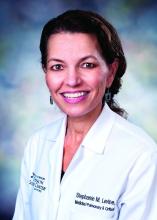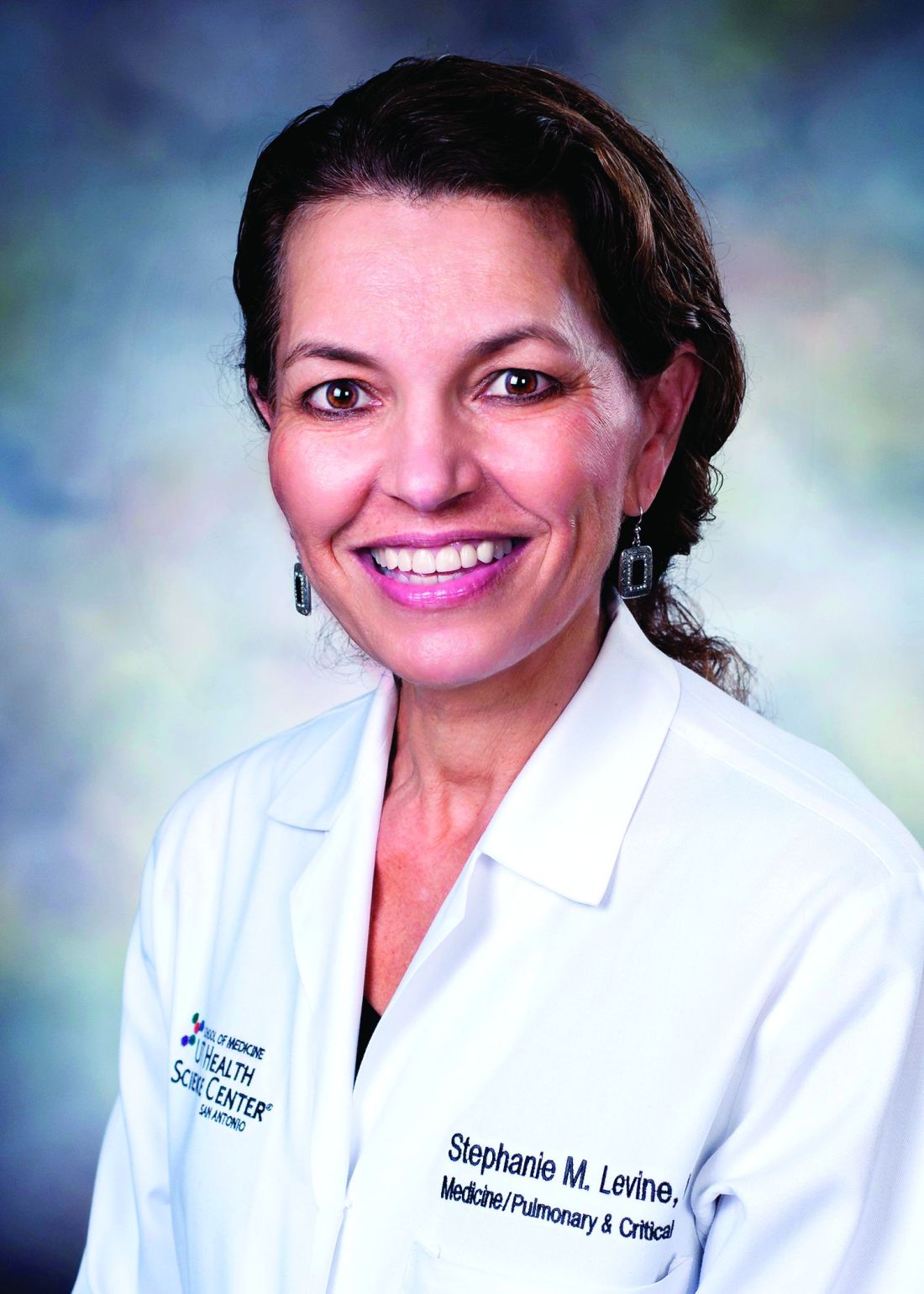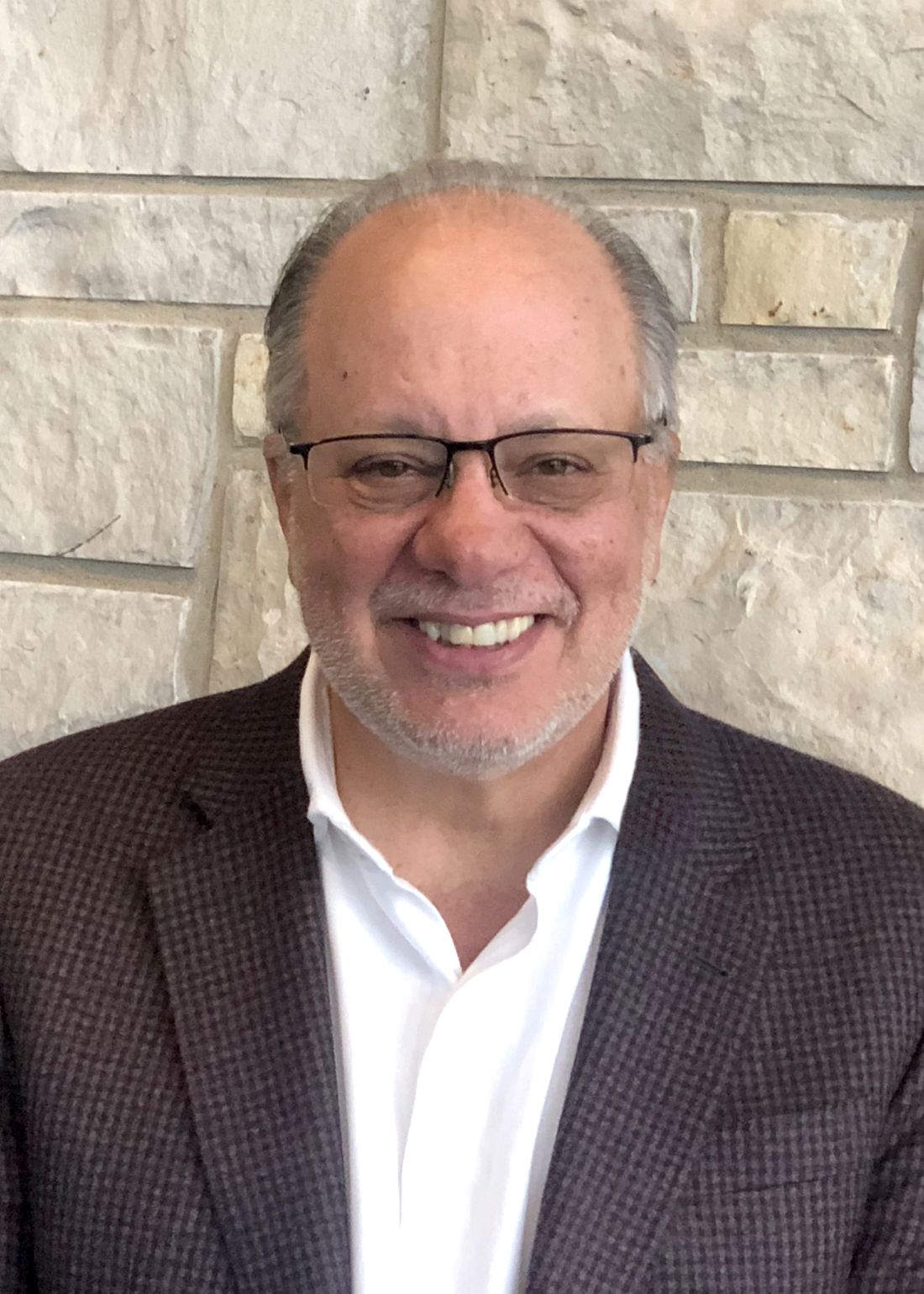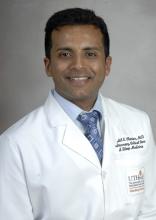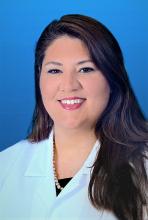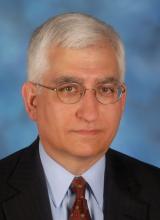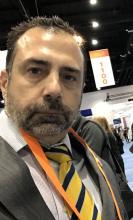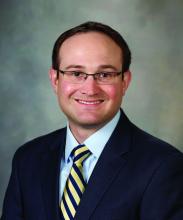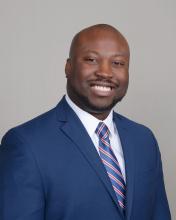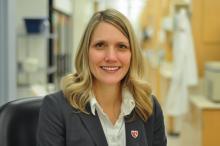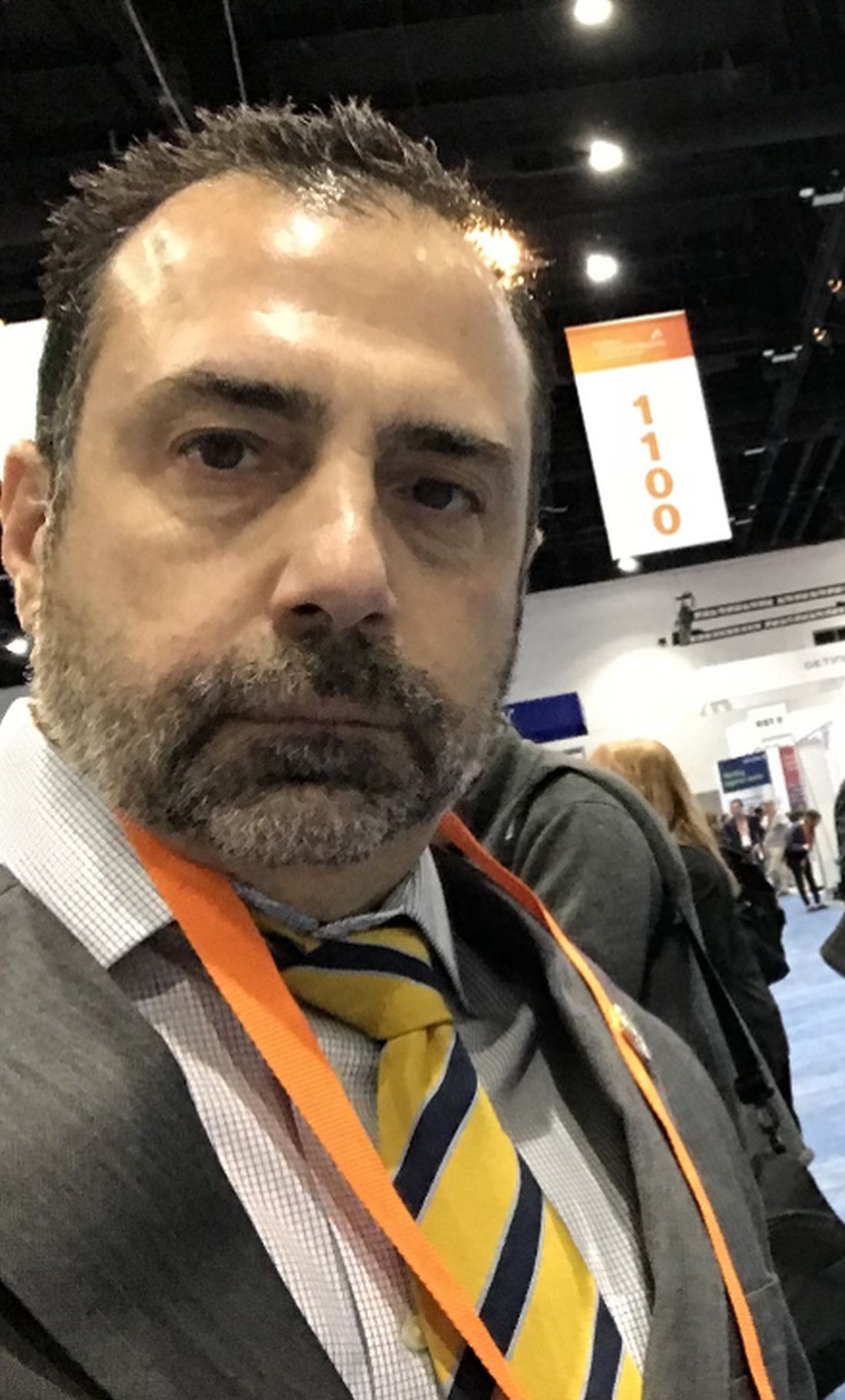User login
President’s report
As I write, I must admit this message is different than the one I’d envisioned sharing with you weeks ago. I anticipated updating you on meetings and collaborations with sister societies, new educational offerings, and how the Bologna World Congress and Annual Meeting plans were progressing, but activities at CHEST – and our sense of priority – have evolved along with those of our global community.
Pulmonary and critical care providers are now at the forefront of health care. Our patients, and now the greater public, are relying on our efforts and those of our teams. Amid this crisis, there is a renewed appreciation for the work all of you do; and with it, an opportunity for CHEST to lead and help ensure that the profession and our systems emerge stronger.
Back in February, we held the program committee meeting for the Annual Meeting with over 1000 submissions. It is astounding how the program came together over just a few days thanks to the preemptive work done by Chair, Dr. Victor Test, and, Co-Chair, Dr. Christopher Carroll, and all of the curricular groups, program committee members, and staff putting in so much work prior to the face-to-face meeting. Also during February, CHEST leadership held the Forum of International Respiratory Societies’ (FIRS) strategic planning meeting. The main outcome is a plan to engage a lobbyist to represent the worldwide respiratory societies in the WHO in Geneva on universal topics such as air pollution and now, unfortunately, COVID-19. CHEST was represented at the Society of Critical Care Medicine (SCCM) Congress where we heard late-breaking information as the pandemic was beginning to unfold. We met with the Critical Care Societies Collaborative (CCSC), which is composed of representatives from CHEST, SCCM, the American Thoracic Society (ATS), and the American Association of Critical-Care Nurses (AACN). We had an opportunity to meet with the European Society of Intensive Care Medicine (ESICM) and initiate discussions toward future collaboration.
In early March, as COVID-19 began to interfere with in-person meetings, we participated virtually in the NAMDRC meeting, and finalized our commitment to formally joining forces under the umbrella of CHEST to better serve our members in the area of advocacy. To this end, a new standing CHEST committee was founded, consisting of members from the former NAMRDC Board and members from the CHEST Board of Regents and Board of Trustees and chaired by Dr. Neil Freedman and Dr. Jim Lamberti. We look forward to hosting advocacy sessions during our October meeting, and going forward, our Spring Leadership Meeting will be combined with the former NAMDRC meeting to allow our leaders to participate in advocacy efforts. We will continue to publish the Washington Watchline, bringing important news on efforts to enhance access to care and our ability to deliver it effectively. Our spring leadership meetings, board meetings, and committee meetings in early April were held virtually in light of the pandemic.
Since March, CHEST has been heavily immersed in COVID-19 preparation with new plans for alternate methods of educational delivery, new business models, and curtailment of travel on both our home fronts and on the CHEST front. Zoom and like platforms are now my best friend! Our daily vocabulary now includes an abundance of caution, surge, sheltering in place, quarantine, social distancing, flattening the curve, tele-medicine, and don and doff, and we close e-mails, texts, and phone calls with Stay Safe! I established a COVID task force led by Dr. Steve Simpson (CHEST President-Elect) and with representation from the Critical Care, Chest Infections, and Disaster Response and Global Health NetWorks. They have been meeting weekly with the goals of disseminating and distilling COVID-related materials for the busy practitioner with links to the specific article or statement along with the BLUF (Bottom Line Up Front). I’m sure you were able to see and hear some of the reports by Dr. Mangala Narasimhan and others on the front lines in New York, on the CHEST website, 60 Minutes, and CNN. CHEST held a two-part webinar with our Chinese colleagues who shared their COVID experiences with us. These relationships were in part built from the PCCM Fellowship Training program we conducted with Chinese physicians, led by Dr. Darcy Marciniuk and Dr. Chen Wang under the guidance of Dr. Renli Qiao, and with the help of the late Dr. Mark Rosen, Dr. Jack Buckley, and myself. CHEST has posted a webinar on point of care ultrasound testing in the setting of COVID since many units are now using more POCUS instead of standard imaging for the critically ill. We have also posted some of our board review lectures on demand for those who want to brush up on their critical care skills and knowledge.
CHEST, unfortunately, had to reschedule the Bologna meeting due to the tragic situation in Italy and plans to reconvene the meeting June 24-26 of 2021. As of now, CHEST 2020 in Chicago is a go, but, of course, we will monitor that situation carefully. We have extended the deadline for abstracts and case reports to June 1, 2020, given the ongoing crisis. The team is busy planning for standalone and complementary online offerings to ensure seamless delivery of critical education in formats that cater easily to our newly formed habits.
CHEST staff have been working from home due to the Illinois shelter in place order but continue to work tremendously hard. They are implementing new areas to the website in an effort to improve the user experience by making information easier to find and more timely. In the publishing space, Dr. Peter Mazzone and the journal team have been receiving hundreds of COVID-related publications, which they have been reviewing and expediting for publication where appropriate. There will also be additional podcasts coming from our journal. The guidelines group has been working on shorter expert panel statements in the setting of rapidly changing evidence. And, to keep us all well, there are opportunities to share our personal feelings and experiences with treating those with COVID in video format on the website and across CHEST social media channels. The CHEST and the CHEST Foundation have initiated a new microgrants program and have reached out to over 150 ILD and COPD support groups across the country to offer them the opportunity to apply for a max $2,500 grant. So far, 7seven groups have requested support. These grants go directly to patients and caregivers and provide needed relief through provision of:
1. Groceries
2. Gift cards
3. Medical supplies (including PPE for patients)
4. Technology needed to communicate with their community and HCPs
5. Household supplies, cleaning supplies
In an attempt to assist our colleagues in New York City, a call went out for volunteers at the end of March and has resulted in over 200 volunteers and more than 400 inquiries from our members. Bravo!!! We want to thank our sister societies for joining our efforts during this time to help all of our respective members and, ultimately, those patients stricken with this terrible illness. As I don and doff my COVID gear, I hope you are all safe and well in this time of unprecedented change in our lives. I look forward to my next report in a few months, hopefully on a happier note.
Stay safe!
Stephanie
As I write, I must admit this message is different than the one I’d envisioned sharing with you weeks ago. I anticipated updating you on meetings and collaborations with sister societies, new educational offerings, and how the Bologna World Congress and Annual Meeting plans were progressing, but activities at CHEST – and our sense of priority – have evolved along with those of our global community.
Pulmonary and critical care providers are now at the forefront of health care. Our patients, and now the greater public, are relying on our efforts and those of our teams. Amid this crisis, there is a renewed appreciation for the work all of you do; and with it, an opportunity for CHEST to lead and help ensure that the profession and our systems emerge stronger.
Back in February, we held the program committee meeting for the Annual Meeting with over 1000 submissions. It is astounding how the program came together over just a few days thanks to the preemptive work done by Chair, Dr. Victor Test, and, Co-Chair, Dr. Christopher Carroll, and all of the curricular groups, program committee members, and staff putting in so much work prior to the face-to-face meeting. Also during February, CHEST leadership held the Forum of International Respiratory Societies’ (FIRS) strategic planning meeting. The main outcome is a plan to engage a lobbyist to represent the worldwide respiratory societies in the WHO in Geneva on universal topics such as air pollution and now, unfortunately, COVID-19. CHEST was represented at the Society of Critical Care Medicine (SCCM) Congress where we heard late-breaking information as the pandemic was beginning to unfold. We met with the Critical Care Societies Collaborative (CCSC), which is composed of representatives from CHEST, SCCM, the American Thoracic Society (ATS), and the American Association of Critical-Care Nurses (AACN). We had an opportunity to meet with the European Society of Intensive Care Medicine (ESICM) and initiate discussions toward future collaboration.
In early March, as COVID-19 began to interfere with in-person meetings, we participated virtually in the NAMDRC meeting, and finalized our commitment to formally joining forces under the umbrella of CHEST to better serve our members in the area of advocacy. To this end, a new standing CHEST committee was founded, consisting of members from the former NAMRDC Board and members from the CHEST Board of Regents and Board of Trustees and chaired by Dr. Neil Freedman and Dr. Jim Lamberti. We look forward to hosting advocacy sessions during our October meeting, and going forward, our Spring Leadership Meeting will be combined with the former NAMDRC meeting to allow our leaders to participate in advocacy efforts. We will continue to publish the Washington Watchline, bringing important news on efforts to enhance access to care and our ability to deliver it effectively. Our spring leadership meetings, board meetings, and committee meetings in early April were held virtually in light of the pandemic.
Since March, CHEST has been heavily immersed in COVID-19 preparation with new plans for alternate methods of educational delivery, new business models, and curtailment of travel on both our home fronts and on the CHEST front. Zoom and like platforms are now my best friend! Our daily vocabulary now includes an abundance of caution, surge, sheltering in place, quarantine, social distancing, flattening the curve, tele-medicine, and don and doff, and we close e-mails, texts, and phone calls with Stay Safe! I established a COVID task force led by Dr. Steve Simpson (CHEST President-Elect) and with representation from the Critical Care, Chest Infections, and Disaster Response and Global Health NetWorks. They have been meeting weekly with the goals of disseminating and distilling COVID-related materials for the busy practitioner with links to the specific article or statement along with the BLUF (Bottom Line Up Front). I’m sure you were able to see and hear some of the reports by Dr. Mangala Narasimhan and others on the front lines in New York, on the CHEST website, 60 Minutes, and CNN. CHEST held a two-part webinar with our Chinese colleagues who shared their COVID experiences with us. These relationships were in part built from the PCCM Fellowship Training program we conducted with Chinese physicians, led by Dr. Darcy Marciniuk and Dr. Chen Wang under the guidance of Dr. Renli Qiao, and with the help of the late Dr. Mark Rosen, Dr. Jack Buckley, and myself. CHEST has posted a webinar on point of care ultrasound testing in the setting of COVID since many units are now using more POCUS instead of standard imaging for the critically ill. We have also posted some of our board review lectures on demand for those who want to brush up on their critical care skills and knowledge.
CHEST, unfortunately, had to reschedule the Bologna meeting due to the tragic situation in Italy and plans to reconvene the meeting June 24-26 of 2021. As of now, CHEST 2020 in Chicago is a go, but, of course, we will monitor that situation carefully. We have extended the deadline for abstracts and case reports to June 1, 2020, given the ongoing crisis. The team is busy planning for standalone and complementary online offerings to ensure seamless delivery of critical education in formats that cater easily to our newly formed habits.
CHEST staff have been working from home due to the Illinois shelter in place order but continue to work tremendously hard. They are implementing new areas to the website in an effort to improve the user experience by making information easier to find and more timely. In the publishing space, Dr. Peter Mazzone and the journal team have been receiving hundreds of COVID-related publications, which they have been reviewing and expediting for publication where appropriate. There will also be additional podcasts coming from our journal. The guidelines group has been working on shorter expert panel statements in the setting of rapidly changing evidence. And, to keep us all well, there are opportunities to share our personal feelings and experiences with treating those with COVID in video format on the website and across CHEST social media channels. The CHEST and the CHEST Foundation have initiated a new microgrants program and have reached out to over 150 ILD and COPD support groups across the country to offer them the opportunity to apply for a max $2,500 grant. So far, 7seven groups have requested support. These grants go directly to patients and caregivers and provide needed relief through provision of:
1. Groceries
2. Gift cards
3. Medical supplies (including PPE for patients)
4. Technology needed to communicate with their community and HCPs
5. Household supplies, cleaning supplies
In an attempt to assist our colleagues in New York City, a call went out for volunteers at the end of March and has resulted in over 200 volunteers and more than 400 inquiries from our members. Bravo!!! We want to thank our sister societies for joining our efforts during this time to help all of our respective members and, ultimately, those patients stricken with this terrible illness. As I don and doff my COVID gear, I hope you are all safe and well in this time of unprecedented change in our lives. I look forward to my next report in a few months, hopefully on a happier note.
Stay safe!
Stephanie
As I write, I must admit this message is different than the one I’d envisioned sharing with you weeks ago. I anticipated updating you on meetings and collaborations with sister societies, new educational offerings, and how the Bologna World Congress and Annual Meeting plans were progressing, but activities at CHEST – and our sense of priority – have evolved along with those of our global community.
Pulmonary and critical care providers are now at the forefront of health care. Our patients, and now the greater public, are relying on our efforts and those of our teams. Amid this crisis, there is a renewed appreciation for the work all of you do; and with it, an opportunity for CHEST to lead and help ensure that the profession and our systems emerge stronger.
Back in February, we held the program committee meeting for the Annual Meeting with over 1000 submissions. It is astounding how the program came together over just a few days thanks to the preemptive work done by Chair, Dr. Victor Test, and, Co-Chair, Dr. Christopher Carroll, and all of the curricular groups, program committee members, and staff putting in so much work prior to the face-to-face meeting. Also during February, CHEST leadership held the Forum of International Respiratory Societies’ (FIRS) strategic planning meeting. The main outcome is a plan to engage a lobbyist to represent the worldwide respiratory societies in the WHO in Geneva on universal topics such as air pollution and now, unfortunately, COVID-19. CHEST was represented at the Society of Critical Care Medicine (SCCM) Congress where we heard late-breaking information as the pandemic was beginning to unfold. We met with the Critical Care Societies Collaborative (CCSC), which is composed of representatives from CHEST, SCCM, the American Thoracic Society (ATS), and the American Association of Critical-Care Nurses (AACN). We had an opportunity to meet with the European Society of Intensive Care Medicine (ESICM) and initiate discussions toward future collaboration.
In early March, as COVID-19 began to interfere with in-person meetings, we participated virtually in the NAMDRC meeting, and finalized our commitment to formally joining forces under the umbrella of CHEST to better serve our members in the area of advocacy. To this end, a new standing CHEST committee was founded, consisting of members from the former NAMRDC Board and members from the CHEST Board of Regents and Board of Trustees and chaired by Dr. Neil Freedman and Dr. Jim Lamberti. We look forward to hosting advocacy sessions during our October meeting, and going forward, our Spring Leadership Meeting will be combined with the former NAMDRC meeting to allow our leaders to participate in advocacy efforts. We will continue to publish the Washington Watchline, bringing important news on efforts to enhance access to care and our ability to deliver it effectively. Our spring leadership meetings, board meetings, and committee meetings in early April were held virtually in light of the pandemic.
Since March, CHEST has been heavily immersed in COVID-19 preparation with new plans for alternate methods of educational delivery, new business models, and curtailment of travel on both our home fronts and on the CHEST front. Zoom and like platforms are now my best friend! Our daily vocabulary now includes an abundance of caution, surge, sheltering in place, quarantine, social distancing, flattening the curve, tele-medicine, and don and doff, and we close e-mails, texts, and phone calls with Stay Safe! I established a COVID task force led by Dr. Steve Simpson (CHEST President-Elect) and with representation from the Critical Care, Chest Infections, and Disaster Response and Global Health NetWorks. They have been meeting weekly with the goals of disseminating and distilling COVID-related materials for the busy practitioner with links to the specific article or statement along with the BLUF (Bottom Line Up Front). I’m sure you were able to see and hear some of the reports by Dr. Mangala Narasimhan and others on the front lines in New York, on the CHEST website, 60 Minutes, and CNN. CHEST held a two-part webinar with our Chinese colleagues who shared their COVID experiences with us. These relationships were in part built from the PCCM Fellowship Training program we conducted with Chinese physicians, led by Dr. Darcy Marciniuk and Dr. Chen Wang under the guidance of Dr. Renli Qiao, and with the help of the late Dr. Mark Rosen, Dr. Jack Buckley, and myself. CHEST has posted a webinar on point of care ultrasound testing in the setting of COVID since many units are now using more POCUS instead of standard imaging for the critically ill. We have also posted some of our board review lectures on demand for those who want to brush up on their critical care skills and knowledge.
CHEST, unfortunately, had to reschedule the Bologna meeting due to the tragic situation in Italy and plans to reconvene the meeting June 24-26 of 2021. As of now, CHEST 2020 in Chicago is a go, but, of course, we will monitor that situation carefully. We have extended the deadline for abstracts and case reports to June 1, 2020, given the ongoing crisis. The team is busy planning for standalone and complementary online offerings to ensure seamless delivery of critical education in formats that cater easily to our newly formed habits.
CHEST staff have been working from home due to the Illinois shelter in place order but continue to work tremendously hard. They are implementing new areas to the website in an effort to improve the user experience by making information easier to find and more timely. In the publishing space, Dr. Peter Mazzone and the journal team have been receiving hundreds of COVID-related publications, which they have been reviewing and expediting for publication where appropriate. There will also be additional podcasts coming from our journal. The guidelines group has been working on shorter expert panel statements in the setting of rapidly changing evidence. And, to keep us all well, there are opportunities to share our personal feelings and experiences with treating those with COVID in video format on the website and across CHEST social media channels. The CHEST and the CHEST Foundation have initiated a new microgrants program and have reached out to over 150 ILD and COPD support groups across the country to offer them the opportunity to apply for a max $2,500 grant. So far, 7seven groups have requested support. These grants go directly to patients and caregivers and provide needed relief through provision of:
1. Groceries
2. Gift cards
3. Medical supplies (including PPE for patients)
4. Technology needed to communicate with their community and HCPs
5. Household supplies, cleaning supplies
In an attempt to assist our colleagues in New York City, a call went out for volunteers at the end of March and has resulted in over 200 volunteers and more than 400 inquiries from our members. Bravo!!! We want to thank our sister societies for joining our efforts during this time to help all of our respective members and, ultimately, those patients stricken with this terrible illness. As I don and doff my COVID gear, I hope you are all safe and well in this time of unprecedented change in our lives. I look forward to my next report in a few months, hopefully on a happier note.
Stay safe!
Stephanie
From the EVP/CEO: How CHEST is helping to flatten the curve
As you know, the COVID-19 pandemic has caused immense strain on global health systems. With our membership at the epicenter, many of you have experienced firsthand the shortages that result from a surging patient population – lack of personal protective equipment (PPE), access to ventilators, and increasing demand for more qualified health-care workers needed on the front lines to treat and care for patients. As the staff leader of your organization, I feel an immense responsibility to support our community through this crisis.
In recent weeks, CHEST petitioned the federal and local governments on several issues, advocating for tax relief for COVID responders, expansion of liability protections, and the development of a provider relief fund. We will continue to collaborate with other societies and push such efforts. However, we also recognize an obligation to make a more tangible, real-time difference in the circumstances of our membership and the lives of the patients you are working to save.
An opportunity arose when we received a call from Dr. Doreen Addrizzo-Harris, Immediate Past President of the CHEST Foundation and Professor of Medicine at NYU Langone Health. In late March, New York City was seeing an uptick in patients with confirmed COVID infection in critical condition that was escalating by the day. The situation was beginning to resemble the trajectory of hotspots in Wuhan, China and Italy, and it was already taking a toll on health-care teams. Dr. Adrizzo-Harris asked whether there was any way to leverage the strength of the CHEST community to provide help. Already, our headquarters team had received unsolicited offers to travel to areas in need from our members. The question was how could we more proactively identify such willing and able clinicians.
We quickly drew upon our existing CHEST Analytics platform to target physicians outside New York City who might be well-positioned to travel. We harnessed our communication channels to get the word out. The response was immediate, with more than 100 people completing applications to join forces with their colleagues in New York. In the first 10 days of recruitment efforts, we added an additional 250 interested volunteers to the system. The positive response from members showed both the willingness of qualified medical staff to assist on the front lines but also highlighted deficiencies in other registration systems overwhelmed with requests in the face of this pandemic. Finding certified pulmonary and critical care physicians who are willing to step in where they are needed is time- and labor-intensive and detracts from health systems’ ability to focus on care. Watching the projections in other regions, we recognized other areas may soon need this same help.
With this in mind, CHEST approached ATS and our long-time partner PA Consulting to help us address the problem on a national scale. We felt we had the resources to leverage our databases and our analytic tools to create a more efficient process that would put physicians in hospitals where they could do the most good more efficiently. We knew that if we could apply our knowledge and deploy our heroic members, we could develop a solution that could save lives and relieve frontline clinicians. By leveraging the existing CHEST Analytics platform, the team created a solution that can be used by provider institutions, government agencies, and willing clinicians to quickly and effectively provide care where it is needed most. The team has engineered the solution to be scalable nationally and expandable to other critical care specialties (eg, anesthesia, emergency, nursing, respiratory therapy).
The Clinician Matching Network formally launched on April 14, 2020. It provides a two-way input that accepts sign up from individual clinicians and gathers needs and requirements from hospital systems, connecting health-care providers with the systems most in need of the specific support they are equipped to provide. We believe this has the potential to enable us to move ahead of the curve of the crisis.
I am very proud of the teams that lead this effort and have gained a greater appreciation of how CHEST, in partnership with other medical societies, can fully utilize data and analytics toward implementing public health solutions. The design and development of the Clinician Matching Network was accomplished in less than a week, leveraging a methodology that will enable the team to continuously improve and iterate through weekly releases, adding functionality quickly as the pandemic evolves.
In the weeks ahead, communications will be distributed to hospitals and hospital systems to help identify their staffing needs, encourage them to input their needs into the Clinician Matching Network, and expand the clinician-to-hospital matching effort. We aim to increase the number of collaborationg associations to grow the pool of clinicians who can be deployed to areas in need.
Please visit www.chestnet.org/clinician-matching to learn more, sign up to serve, tell us about the needs of your institution, or collaborate toward this cause.
As you know, the COVID-19 pandemic has caused immense strain on global health systems. With our membership at the epicenter, many of you have experienced firsthand the shortages that result from a surging patient population – lack of personal protective equipment (PPE), access to ventilators, and increasing demand for more qualified health-care workers needed on the front lines to treat and care for patients. As the staff leader of your organization, I feel an immense responsibility to support our community through this crisis.
In recent weeks, CHEST petitioned the federal and local governments on several issues, advocating for tax relief for COVID responders, expansion of liability protections, and the development of a provider relief fund. We will continue to collaborate with other societies and push such efforts. However, we also recognize an obligation to make a more tangible, real-time difference in the circumstances of our membership and the lives of the patients you are working to save.
An opportunity arose when we received a call from Dr. Doreen Addrizzo-Harris, Immediate Past President of the CHEST Foundation and Professor of Medicine at NYU Langone Health. In late March, New York City was seeing an uptick in patients with confirmed COVID infection in critical condition that was escalating by the day. The situation was beginning to resemble the trajectory of hotspots in Wuhan, China and Italy, and it was already taking a toll on health-care teams. Dr. Adrizzo-Harris asked whether there was any way to leverage the strength of the CHEST community to provide help. Already, our headquarters team had received unsolicited offers to travel to areas in need from our members. The question was how could we more proactively identify such willing and able clinicians.
We quickly drew upon our existing CHEST Analytics platform to target physicians outside New York City who might be well-positioned to travel. We harnessed our communication channels to get the word out. The response was immediate, with more than 100 people completing applications to join forces with their colleagues in New York. In the first 10 days of recruitment efforts, we added an additional 250 interested volunteers to the system. The positive response from members showed both the willingness of qualified medical staff to assist on the front lines but also highlighted deficiencies in other registration systems overwhelmed with requests in the face of this pandemic. Finding certified pulmonary and critical care physicians who are willing to step in where they are needed is time- and labor-intensive and detracts from health systems’ ability to focus on care. Watching the projections in other regions, we recognized other areas may soon need this same help.
With this in mind, CHEST approached ATS and our long-time partner PA Consulting to help us address the problem on a national scale. We felt we had the resources to leverage our databases and our analytic tools to create a more efficient process that would put physicians in hospitals where they could do the most good more efficiently. We knew that if we could apply our knowledge and deploy our heroic members, we could develop a solution that could save lives and relieve frontline clinicians. By leveraging the existing CHEST Analytics platform, the team created a solution that can be used by provider institutions, government agencies, and willing clinicians to quickly and effectively provide care where it is needed most. The team has engineered the solution to be scalable nationally and expandable to other critical care specialties (eg, anesthesia, emergency, nursing, respiratory therapy).
The Clinician Matching Network formally launched on April 14, 2020. It provides a two-way input that accepts sign up from individual clinicians and gathers needs and requirements from hospital systems, connecting health-care providers with the systems most in need of the specific support they are equipped to provide. We believe this has the potential to enable us to move ahead of the curve of the crisis.
I am very proud of the teams that lead this effort and have gained a greater appreciation of how CHEST, in partnership with other medical societies, can fully utilize data and analytics toward implementing public health solutions. The design and development of the Clinician Matching Network was accomplished in less than a week, leveraging a methodology that will enable the team to continuously improve and iterate through weekly releases, adding functionality quickly as the pandemic evolves.
In the weeks ahead, communications will be distributed to hospitals and hospital systems to help identify their staffing needs, encourage them to input their needs into the Clinician Matching Network, and expand the clinician-to-hospital matching effort. We aim to increase the number of collaborationg associations to grow the pool of clinicians who can be deployed to areas in need.
Please visit www.chestnet.org/clinician-matching to learn more, sign up to serve, tell us about the needs of your institution, or collaborate toward this cause.
As you know, the COVID-19 pandemic has caused immense strain on global health systems. With our membership at the epicenter, many of you have experienced firsthand the shortages that result from a surging patient population – lack of personal protective equipment (PPE), access to ventilators, and increasing demand for more qualified health-care workers needed on the front lines to treat and care for patients. As the staff leader of your organization, I feel an immense responsibility to support our community through this crisis.
In recent weeks, CHEST petitioned the federal and local governments on several issues, advocating for tax relief for COVID responders, expansion of liability protections, and the development of a provider relief fund. We will continue to collaborate with other societies and push such efforts. However, we also recognize an obligation to make a more tangible, real-time difference in the circumstances of our membership and the lives of the patients you are working to save.
An opportunity arose when we received a call from Dr. Doreen Addrizzo-Harris, Immediate Past President of the CHEST Foundation and Professor of Medicine at NYU Langone Health. In late March, New York City was seeing an uptick in patients with confirmed COVID infection in critical condition that was escalating by the day. The situation was beginning to resemble the trajectory of hotspots in Wuhan, China and Italy, and it was already taking a toll on health-care teams. Dr. Adrizzo-Harris asked whether there was any way to leverage the strength of the CHEST community to provide help. Already, our headquarters team had received unsolicited offers to travel to areas in need from our members. The question was how could we more proactively identify such willing and able clinicians.
We quickly drew upon our existing CHEST Analytics platform to target physicians outside New York City who might be well-positioned to travel. We harnessed our communication channels to get the word out. The response was immediate, with more than 100 people completing applications to join forces with their colleagues in New York. In the first 10 days of recruitment efforts, we added an additional 250 interested volunteers to the system. The positive response from members showed both the willingness of qualified medical staff to assist on the front lines but also highlighted deficiencies in other registration systems overwhelmed with requests in the face of this pandemic. Finding certified pulmonary and critical care physicians who are willing to step in where they are needed is time- and labor-intensive and detracts from health systems’ ability to focus on care. Watching the projections in other regions, we recognized other areas may soon need this same help.
With this in mind, CHEST approached ATS and our long-time partner PA Consulting to help us address the problem on a national scale. We felt we had the resources to leverage our databases and our analytic tools to create a more efficient process that would put physicians in hospitals where they could do the most good more efficiently. We knew that if we could apply our knowledge and deploy our heroic members, we could develop a solution that could save lives and relieve frontline clinicians. By leveraging the existing CHEST Analytics platform, the team created a solution that can be used by provider institutions, government agencies, and willing clinicians to quickly and effectively provide care where it is needed most. The team has engineered the solution to be scalable nationally and expandable to other critical care specialties (eg, anesthesia, emergency, nursing, respiratory therapy).
The Clinician Matching Network formally launched on April 14, 2020. It provides a two-way input that accepts sign up from individual clinicians and gathers needs and requirements from hospital systems, connecting health-care providers with the systems most in need of the specific support they are equipped to provide. We believe this has the potential to enable us to move ahead of the curve of the crisis.
I am very proud of the teams that lead this effort and have gained a greater appreciation of how CHEST, in partnership with other medical societies, can fully utilize data and analytics toward implementing public health solutions. The design and development of the Clinician Matching Network was accomplished in less than a week, leveraging a methodology that will enable the team to continuously improve and iterate through weekly releases, adding functionality quickly as the pandemic evolves.
In the weeks ahead, communications will be distributed to hospitals and hospital systems to help identify their staffing needs, encourage them to input their needs into the Clinician Matching Network, and expand the clinician-to-hospital matching effort. We aim to increase the number of collaborationg associations to grow the pool of clinicians who can be deployed to areas in need.
Please visit www.chestnet.org/clinician-matching to learn more, sign up to serve, tell us about the needs of your institution, or collaborate toward this cause.
Silicosis. Palliative care. Respiratory therapy. Sleep apnea. Immunotherapy.
Occupational and Environmental Health
Severe silicosis in engineered stone fabrication workers: An emerging epidemic
Silicosis is an irreversible fibrotic lung disease caused by inhalation of respirable forms of crystalline silica. Silica exposure is also associated with increased risk for mycobacterial infections, lung cancer, emphysema, autoimmune diseases, and kidney disease (Leung CC, et al. Lancet. 2012;379[9830]:2008; Bang KM, et al. MMWR. 2015;64[5]:117). Engineered stone is a manufactured quartz-based composite increasingly used for countertops in the United States where imports of engineered stone for this use have increased around 800% from 2010 to 2018. With this, reported silicosis cases among engineered stone fabrication workers have risen. Silica content in different stones varies from up to 45% in natural stones (granite) to >90% in engineered stone and quartz. The act of cutting, grinding, sanding, drilling, polishing, and installing this stone puts workers with direct and indirect contact with these tasks at risk for hazardous levels of inhaled silica exposure (OSHA et al. https://www.osha.gov/Publications/OSHA3768.pdf. 2015).
A growing number of cases associated with stone fabrication have been reported worldwide (Kramer MR, et al. Chest. 2012;142[2]:419; Kirby T. Lancet. 2019;393:861). The CDC recently published a report of 18 cases of accelerated silicosis over a two-year period among engineered stone fabrication workers. The majority of patients were aged <50 years, five patients had autoimmune disease, two patients had latent TB, and two died (Rose C, et al. MMWR. 2019;68[38]:813). Thus, the experience of engineered stone fabrication workers appears to parallel that of patient exposed to silica in other occupations.
Control measures (see resources below) for silica exposure, prevention, and medical surveillance have been updated since 2016 at the federal level prompting a recent revision of OSHA’s National Emphasis Program for respirable crystalline silica as of February 2020 (OSHA, https://www.osha.gov/news/newsreleases/trade/02052020, published February 5, 2020). Despite these measures, enforcement within the stone fabrication industry remains challenging. Small-scale operations with limited expertise in exposure control combined with high density of immigrant workers with limited health-care access and potential threat of retaliation have limited compliance with updated standards (Rose C, et al. MMWR. 2019;68[38]:813).
Silicosis is preventable, and efforts to minimize workplace exposure and enhance medical surveillance of stone fabrication workers should be prioritized.
Useful resources for silica workplace control measures:
https://www.cdph.ca.gov/silica-stonefabricators
https://www.cdc.gov/niosh/topics/silica/
https://www.osha.gov/sites/default/files/enforcement/directives/CPL_03-00-023.pdf
Sujith Cherian MD, FCCP
Haala Rokadia MD, FCCP
Steering Committee Members
Palliative and end-of-life care
Building primary palliative care competencies in the CHEST community
The CHEST community cares for many patients with serious illnesses characterized by a high risk of mortality, burdensome symptoms or treatments, and caregiver distress, which negatively impact quality of life (QOL) (Kelly, et al. J Palliat Med. 2018;21[S2]:S7). Specialist palliative care (PC) clinicians work in partnership with other specialties to optimize QOL and alleviate suffering for seriously ill patients (i.e., advanced or chronic respiratory disease and/or critical illness).
Referral for specialist PC integration should be based on the complex needs of patients and not prognosis. PC can and should be delivered alongside disease-directed and life-prolonging therapies. Early PC referral in serious illness has been associated with improved QOL, better prognostic awareness, and, in some instances, increased survival. Additionally, reductions in medical costs at the end-of-life have been observed with early PC integration (Parikh, et al. N Engl J Med. 2013;369[24]:2347). However, patients with chronic or advanced respiratory diseases often receive PC late, if at all (Brown, et al. Ann Am Thorac Soc. 2016;13[5]:684). This might be explained by significant shortages within the PC workforce, misconceptions that PC is only delivered at the end of life, and limited proficiency or comfort in primary PC delivery. Primary PC competencies have already been defined for pulmonary and critical care clinicians (Lanken, et al. Am J Respir Crit Care Med. 2008;177:912). The Palliative and End-of-Life Care NetWork is focused on promoting awareness of specialty PC while providing education and resources to support primary PC competencies within the CHEST community. Look for NetWork-sponsored sessions at the annual meeting and follow conversations on social media using the hashtag #CHESTPalCare.
Dina Khateeb, DO
Fellow-in-Training Member
Respiratory care
I am a new respiratory therapist and a team member
It’s 11:00 pm and relatively quiet in the ICU. Then, that all too familiar sound, Code Blue. I rush to the room and assess the situation. As a new grad, this is one of the skills I am still developing; balancing my adrenaline with critical thinking in order to help manage the situation. Whether it is an unplanned extubation, acute respiratory failure, or cardiac arrest, as the respiratory therapist, I am there to bring an expertise to the assessment and management of airway and breathing. Once the crisis is resolved, my work is not done. I remain at the bedside to ensure ventilator management, explain to the family the respiratory interventions, and work with the medical team to implement the best plan of care.
As the bedside RT, I have unique perspective and training. My education prepared me with the knowledge base to work in this arena, but I still have so much to learn. And, as a new grad, one of the biggest lessons I have learned so far is to speak up. Whether it is during rounds, a code situation, or just conversations with the team. I owe it to my patients to advocate for their care and provide the expertise that I bring to the team. To the doctor or nurse, I hope you will give me that opportunity to help care for our patients; to learn; and even teach to improve that care.
Bethlehem Markos
Fellow-in-Training Member
Sleep medicine
What’s new in the sleep apnea treatment pipeline?
While weight loss in obese patients with sleep apnea is an effective treatment strategy, researchers honed in on a particular site of impact – the tongue fat (Wang SH, et al. Am J Respir Crit Care Med.2020;201[6]:718). After a weight loss program, they studied the changes in the tongue, pterygoid, lateral pharyngeal wall, and abdominal fat volumes using MRI. It turned out that reduced tongue fat volume was the primary mediator associated with AHI improvement. The authors suggested a reduction in tongue fat volume may be a potential OSA treatment strategy. Future studies will tell whether this is feasible and effective.
Recently, the FDA approved a new medication to treat residual daytime sleepiness in patients with sleep apnea – solriamfetol. Like other wake-promoting agents, it acts on the central nervous system and improves the reuptake of dopamine and norepinephrine. We look forward to head-to-head studies with current agents (modafinil or armodafinil).
Though not entirely new, two devices have been gaining popularity for sleep apnea treatment. Both are nerve stimulators: one designed for obstructive sleep apnea, is a hypoglossal nerve stimulator; the other, a treatment for central sleep apnea, is a phrenic nerve stimulator. They are slowly gaining popularity, though their invasive nature, patient selection criteria, and cost may limit their widespread adaption. More importantly, data on long-term outcomes and impact on hard endpoints such as mortality and reduction in cardiovascular morbidity are sparse.
Ritwick Agrawal, MD, MS, FCCP
Steering Committee Member
Thoracic oncology
The long and winding treatment road of advanced lung cancer: Long-term outcomes with immunotherapy
Immune checkpoint inhibitors (ICIs) have transformed the landscape in advanced non-small cell lung cancer (NSCLC) treatment, extending progression-free survival (PFS) and overall survival (OS).
Pembrolizumab is approved in advanced NSCLC with ≥50% PD-L1 expression based on KEYNOTE-024 trial.1 Recent updated analysis of KEYNOTE 024 trial2 showed that patients with advanced NSCLC treated with pembrolizumab had a median OS of 30.0 months compared with 14.2 months for those treated with chemotherapy. More recently, 5-year outcomes of KEYNOTE-001 trial3 showed that OS was 23.2% for treatment-naive patients and 15.5% for previously treated patients with no grade 4 or 5 treatment-related adverse events.
Nivolumab is approved for the treatment of patients with advanced NSCLC with progression of disease after standard chemotherapy (regardless of PD-L1 expression) based on CHECKMATE 017/057 trials.4,5 OS at 5 years in recently presented pooled analysis of these trials was 13.4% in nivolumab arm compared to 2.6% in docetaxel arm with a PFS of 8% and 0% respectively.6,7 Median duration of response was 19.9 months vs 5.6 months. At 5 years, almost one-third of patients who responded to the nivolumab were without disease progression. Similarly, a recent 5-year analysis of patients with advanced NSCLC treated with nivolumab showed OS of 16%, identical for squamous and nonsquamous histology. 75% of 5-year survivors were without disease progression.8
Treatment with immunotherapy in advanced NSCLC has resulted in a dramatic change in outcomes with a small percent of patients able to achieve durable responses.
Hiren Mehta, MD, FCCP
Steering Committee Member
References
1. N Engl J Med. 2016; 375:1823.
2. J Clin Oncol. 2019; 37:537.
3. J Clin Oncol. 2019; 37:2518.
4. N Engl J Med. 2015; 373:123.
5. N Engl J Med. 2015; 373:1627.6. J Clin Oncol 2017; 35:3924.
7. https://wclc2019.iaslc.org/wp-content/uploads/2019/08/WCLC2019-Abstract-Book_web-friendly.pdf
8. J Clin Oncol. 2018;36:1675.
Occupational and Environmental Health
Severe silicosis in engineered stone fabrication workers: An emerging epidemic
Silicosis is an irreversible fibrotic lung disease caused by inhalation of respirable forms of crystalline silica. Silica exposure is also associated with increased risk for mycobacterial infections, lung cancer, emphysema, autoimmune diseases, and kidney disease (Leung CC, et al. Lancet. 2012;379[9830]:2008; Bang KM, et al. MMWR. 2015;64[5]:117). Engineered stone is a manufactured quartz-based composite increasingly used for countertops in the United States where imports of engineered stone for this use have increased around 800% from 2010 to 2018. With this, reported silicosis cases among engineered stone fabrication workers have risen. Silica content in different stones varies from up to 45% in natural stones (granite) to >90% in engineered stone and quartz. The act of cutting, grinding, sanding, drilling, polishing, and installing this stone puts workers with direct and indirect contact with these tasks at risk for hazardous levels of inhaled silica exposure (OSHA et al. https://www.osha.gov/Publications/OSHA3768.pdf. 2015).
A growing number of cases associated with stone fabrication have been reported worldwide (Kramer MR, et al. Chest. 2012;142[2]:419; Kirby T. Lancet. 2019;393:861). The CDC recently published a report of 18 cases of accelerated silicosis over a two-year period among engineered stone fabrication workers. The majority of patients were aged <50 years, five patients had autoimmune disease, two patients had latent TB, and two died (Rose C, et al. MMWR. 2019;68[38]:813). Thus, the experience of engineered stone fabrication workers appears to parallel that of patient exposed to silica in other occupations.
Control measures (see resources below) for silica exposure, prevention, and medical surveillance have been updated since 2016 at the federal level prompting a recent revision of OSHA’s National Emphasis Program for respirable crystalline silica as of February 2020 (OSHA, https://www.osha.gov/news/newsreleases/trade/02052020, published February 5, 2020). Despite these measures, enforcement within the stone fabrication industry remains challenging. Small-scale operations with limited expertise in exposure control combined with high density of immigrant workers with limited health-care access and potential threat of retaliation have limited compliance with updated standards (Rose C, et al. MMWR. 2019;68[38]:813).
Silicosis is preventable, and efforts to minimize workplace exposure and enhance medical surveillance of stone fabrication workers should be prioritized.
Useful resources for silica workplace control measures:
https://www.cdph.ca.gov/silica-stonefabricators
https://www.cdc.gov/niosh/topics/silica/
https://www.osha.gov/sites/default/files/enforcement/directives/CPL_03-00-023.pdf
Sujith Cherian MD, FCCP
Haala Rokadia MD, FCCP
Steering Committee Members
Palliative and end-of-life care
Building primary palliative care competencies in the CHEST community
The CHEST community cares for many patients with serious illnesses characterized by a high risk of mortality, burdensome symptoms or treatments, and caregiver distress, which negatively impact quality of life (QOL) (Kelly, et al. J Palliat Med. 2018;21[S2]:S7). Specialist palliative care (PC) clinicians work in partnership with other specialties to optimize QOL and alleviate suffering for seriously ill patients (i.e., advanced or chronic respiratory disease and/or critical illness).
Referral for specialist PC integration should be based on the complex needs of patients and not prognosis. PC can and should be delivered alongside disease-directed and life-prolonging therapies. Early PC referral in serious illness has been associated with improved QOL, better prognostic awareness, and, in some instances, increased survival. Additionally, reductions in medical costs at the end-of-life have been observed with early PC integration (Parikh, et al. N Engl J Med. 2013;369[24]:2347). However, patients with chronic or advanced respiratory diseases often receive PC late, if at all (Brown, et al. Ann Am Thorac Soc. 2016;13[5]:684). This might be explained by significant shortages within the PC workforce, misconceptions that PC is only delivered at the end of life, and limited proficiency or comfort in primary PC delivery. Primary PC competencies have already been defined for pulmonary and critical care clinicians (Lanken, et al. Am J Respir Crit Care Med. 2008;177:912). The Palliative and End-of-Life Care NetWork is focused on promoting awareness of specialty PC while providing education and resources to support primary PC competencies within the CHEST community. Look for NetWork-sponsored sessions at the annual meeting and follow conversations on social media using the hashtag #CHESTPalCare.
Dina Khateeb, DO
Fellow-in-Training Member
Respiratory care
I am a new respiratory therapist and a team member
It’s 11:00 pm and relatively quiet in the ICU. Then, that all too familiar sound, Code Blue. I rush to the room and assess the situation. As a new grad, this is one of the skills I am still developing; balancing my adrenaline with critical thinking in order to help manage the situation. Whether it is an unplanned extubation, acute respiratory failure, or cardiac arrest, as the respiratory therapist, I am there to bring an expertise to the assessment and management of airway and breathing. Once the crisis is resolved, my work is not done. I remain at the bedside to ensure ventilator management, explain to the family the respiratory interventions, and work with the medical team to implement the best plan of care.
As the bedside RT, I have unique perspective and training. My education prepared me with the knowledge base to work in this arena, but I still have so much to learn. And, as a new grad, one of the biggest lessons I have learned so far is to speak up. Whether it is during rounds, a code situation, or just conversations with the team. I owe it to my patients to advocate for their care and provide the expertise that I bring to the team. To the doctor or nurse, I hope you will give me that opportunity to help care for our patients; to learn; and even teach to improve that care.
Bethlehem Markos
Fellow-in-Training Member
Sleep medicine
What’s new in the sleep apnea treatment pipeline?
While weight loss in obese patients with sleep apnea is an effective treatment strategy, researchers honed in on a particular site of impact – the tongue fat (Wang SH, et al. Am J Respir Crit Care Med.2020;201[6]:718). After a weight loss program, they studied the changes in the tongue, pterygoid, lateral pharyngeal wall, and abdominal fat volumes using MRI. It turned out that reduced tongue fat volume was the primary mediator associated with AHI improvement. The authors suggested a reduction in tongue fat volume may be a potential OSA treatment strategy. Future studies will tell whether this is feasible and effective.
Recently, the FDA approved a new medication to treat residual daytime sleepiness in patients with sleep apnea – solriamfetol. Like other wake-promoting agents, it acts on the central nervous system and improves the reuptake of dopamine and norepinephrine. We look forward to head-to-head studies with current agents (modafinil or armodafinil).
Though not entirely new, two devices have been gaining popularity for sleep apnea treatment. Both are nerve stimulators: one designed for obstructive sleep apnea, is a hypoglossal nerve stimulator; the other, a treatment for central sleep apnea, is a phrenic nerve stimulator. They are slowly gaining popularity, though their invasive nature, patient selection criteria, and cost may limit their widespread adaption. More importantly, data on long-term outcomes and impact on hard endpoints such as mortality and reduction in cardiovascular morbidity are sparse.
Ritwick Agrawal, MD, MS, FCCP
Steering Committee Member
Thoracic oncology
The long and winding treatment road of advanced lung cancer: Long-term outcomes with immunotherapy
Immune checkpoint inhibitors (ICIs) have transformed the landscape in advanced non-small cell lung cancer (NSCLC) treatment, extending progression-free survival (PFS) and overall survival (OS).
Pembrolizumab is approved in advanced NSCLC with ≥50% PD-L1 expression based on KEYNOTE-024 trial.1 Recent updated analysis of KEYNOTE 024 trial2 showed that patients with advanced NSCLC treated with pembrolizumab had a median OS of 30.0 months compared with 14.2 months for those treated with chemotherapy. More recently, 5-year outcomes of KEYNOTE-001 trial3 showed that OS was 23.2% for treatment-naive patients and 15.5% for previously treated patients with no grade 4 or 5 treatment-related adverse events.
Nivolumab is approved for the treatment of patients with advanced NSCLC with progression of disease after standard chemotherapy (regardless of PD-L1 expression) based on CHECKMATE 017/057 trials.4,5 OS at 5 years in recently presented pooled analysis of these trials was 13.4% in nivolumab arm compared to 2.6% in docetaxel arm with a PFS of 8% and 0% respectively.6,7 Median duration of response was 19.9 months vs 5.6 months. At 5 years, almost one-third of patients who responded to the nivolumab were without disease progression. Similarly, a recent 5-year analysis of patients with advanced NSCLC treated with nivolumab showed OS of 16%, identical for squamous and nonsquamous histology. 75% of 5-year survivors were without disease progression.8
Treatment with immunotherapy in advanced NSCLC has resulted in a dramatic change in outcomes with a small percent of patients able to achieve durable responses.
Hiren Mehta, MD, FCCP
Steering Committee Member
References
1. N Engl J Med. 2016; 375:1823.
2. J Clin Oncol. 2019; 37:537.
3. J Clin Oncol. 2019; 37:2518.
4. N Engl J Med. 2015; 373:123.
5. N Engl J Med. 2015; 373:1627.6. J Clin Oncol 2017; 35:3924.
7. https://wclc2019.iaslc.org/wp-content/uploads/2019/08/WCLC2019-Abstract-Book_web-friendly.pdf
8. J Clin Oncol. 2018;36:1675.
Occupational and Environmental Health
Severe silicosis in engineered stone fabrication workers: An emerging epidemic
Silicosis is an irreversible fibrotic lung disease caused by inhalation of respirable forms of crystalline silica. Silica exposure is also associated with increased risk for mycobacterial infections, lung cancer, emphysema, autoimmune diseases, and kidney disease (Leung CC, et al. Lancet. 2012;379[9830]:2008; Bang KM, et al. MMWR. 2015;64[5]:117). Engineered stone is a manufactured quartz-based composite increasingly used for countertops in the United States where imports of engineered stone for this use have increased around 800% from 2010 to 2018. With this, reported silicosis cases among engineered stone fabrication workers have risen. Silica content in different stones varies from up to 45% in natural stones (granite) to >90% in engineered stone and quartz. The act of cutting, grinding, sanding, drilling, polishing, and installing this stone puts workers with direct and indirect contact with these tasks at risk for hazardous levels of inhaled silica exposure (OSHA et al. https://www.osha.gov/Publications/OSHA3768.pdf. 2015).
A growing number of cases associated with stone fabrication have been reported worldwide (Kramer MR, et al. Chest. 2012;142[2]:419; Kirby T. Lancet. 2019;393:861). The CDC recently published a report of 18 cases of accelerated silicosis over a two-year period among engineered stone fabrication workers. The majority of patients were aged <50 years, five patients had autoimmune disease, two patients had latent TB, and two died (Rose C, et al. MMWR. 2019;68[38]:813). Thus, the experience of engineered stone fabrication workers appears to parallel that of patient exposed to silica in other occupations.
Control measures (see resources below) for silica exposure, prevention, and medical surveillance have been updated since 2016 at the federal level prompting a recent revision of OSHA’s National Emphasis Program for respirable crystalline silica as of February 2020 (OSHA, https://www.osha.gov/news/newsreleases/trade/02052020, published February 5, 2020). Despite these measures, enforcement within the stone fabrication industry remains challenging. Small-scale operations with limited expertise in exposure control combined with high density of immigrant workers with limited health-care access and potential threat of retaliation have limited compliance with updated standards (Rose C, et al. MMWR. 2019;68[38]:813).
Silicosis is preventable, and efforts to minimize workplace exposure and enhance medical surveillance of stone fabrication workers should be prioritized.
Useful resources for silica workplace control measures:
https://www.cdph.ca.gov/silica-stonefabricators
https://www.cdc.gov/niosh/topics/silica/
https://www.osha.gov/sites/default/files/enforcement/directives/CPL_03-00-023.pdf
Sujith Cherian MD, FCCP
Haala Rokadia MD, FCCP
Steering Committee Members
Palliative and end-of-life care
Building primary palliative care competencies in the CHEST community
The CHEST community cares for many patients with serious illnesses characterized by a high risk of mortality, burdensome symptoms or treatments, and caregiver distress, which negatively impact quality of life (QOL) (Kelly, et al. J Palliat Med. 2018;21[S2]:S7). Specialist palliative care (PC) clinicians work in partnership with other specialties to optimize QOL and alleviate suffering for seriously ill patients (i.e., advanced or chronic respiratory disease and/or critical illness).
Referral for specialist PC integration should be based on the complex needs of patients and not prognosis. PC can and should be delivered alongside disease-directed and life-prolonging therapies. Early PC referral in serious illness has been associated with improved QOL, better prognostic awareness, and, in some instances, increased survival. Additionally, reductions in medical costs at the end-of-life have been observed with early PC integration (Parikh, et al. N Engl J Med. 2013;369[24]:2347). However, patients with chronic or advanced respiratory diseases often receive PC late, if at all (Brown, et al. Ann Am Thorac Soc. 2016;13[5]:684). This might be explained by significant shortages within the PC workforce, misconceptions that PC is only delivered at the end of life, and limited proficiency or comfort in primary PC delivery. Primary PC competencies have already been defined for pulmonary and critical care clinicians (Lanken, et al. Am J Respir Crit Care Med. 2008;177:912). The Palliative and End-of-Life Care NetWork is focused on promoting awareness of specialty PC while providing education and resources to support primary PC competencies within the CHEST community. Look for NetWork-sponsored sessions at the annual meeting and follow conversations on social media using the hashtag #CHESTPalCare.
Dina Khateeb, DO
Fellow-in-Training Member
Respiratory care
I am a new respiratory therapist and a team member
It’s 11:00 pm and relatively quiet in the ICU. Then, that all too familiar sound, Code Blue. I rush to the room and assess the situation. As a new grad, this is one of the skills I am still developing; balancing my adrenaline with critical thinking in order to help manage the situation. Whether it is an unplanned extubation, acute respiratory failure, or cardiac arrest, as the respiratory therapist, I am there to bring an expertise to the assessment and management of airway and breathing. Once the crisis is resolved, my work is not done. I remain at the bedside to ensure ventilator management, explain to the family the respiratory interventions, and work with the medical team to implement the best plan of care.
As the bedside RT, I have unique perspective and training. My education prepared me with the knowledge base to work in this arena, but I still have so much to learn. And, as a new grad, one of the biggest lessons I have learned so far is to speak up. Whether it is during rounds, a code situation, or just conversations with the team. I owe it to my patients to advocate for their care and provide the expertise that I bring to the team. To the doctor or nurse, I hope you will give me that opportunity to help care for our patients; to learn; and even teach to improve that care.
Bethlehem Markos
Fellow-in-Training Member
Sleep medicine
What’s new in the sleep apnea treatment pipeline?
While weight loss in obese patients with sleep apnea is an effective treatment strategy, researchers honed in on a particular site of impact – the tongue fat (Wang SH, et al. Am J Respir Crit Care Med.2020;201[6]:718). After a weight loss program, they studied the changes in the tongue, pterygoid, lateral pharyngeal wall, and abdominal fat volumes using MRI. It turned out that reduced tongue fat volume was the primary mediator associated with AHI improvement. The authors suggested a reduction in tongue fat volume may be a potential OSA treatment strategy. Future studies will tell whether this is feasible and effective.
Recently, the FDA approved a new medication to treat residual daytime sleepiness in patients with sleep apnea – solriamfetol. Like other wake-promoting agents, it acts on the central nervous system and improves the reuptake of dopamine and norepinephrine. We look forward to head-to-head studies with current agents (modafinil or armodafinil).
Though not entirely new, two devices have been gaining popularity for sleep apnea treatment. Both are nerve stimulators: one designed for obstructive sleep apnea, is a hypoglossal nerve stimulator; the other, a treatment for central sleep apnea, is a phrenic nerve stimulator. They are slowly gaining popularity, though their invasive nature, patient selection criteria, and cost may limit their widespread adaption. More importantly, data on long-term outcomes and impact on hard endpoints such as mortality and reduction in cardiovascular morbidity are sparse.
Ritwick Agrawal, MD, MS, FCCP
Steering Committee Member
Thoracic oncology
The long and winding treatment road of advanced lung cancer: Long-term outcomes with immunotherapy
Immune checkpoint inhibitors (ICIs) have transformed the landscape in advanced non-small cell lung cancer (NSCLC) treatment, extending progression-free survival (PFS) and overall survival (OS).
Pembrolizumab is approved in advanced NSCLC with ≥50% PD-L1 expression based on KEYNOTE-024 trial.1 Recent updated analysis of KEYNOTE 024 trial2 showed that patients with advanced NSCLC treated with pembrolizumab had a median OS of 30.0 months compared with 14.2 months for those treated with chemotherapy. More recently, 5-year outcomes of KEYNOTE-001 trial3 showed that OS was 23.2% for treatment-naive patients and 15.5% for previously treated patients with no grade 4 or 5 treatment-related adverse events.
Nivolumab is approved for the treatment of patients with advanced NSCLC with progression of disease after standard chemotherapy (regardless of PD-L1 expression) based on CHECKMATE 017/057 trials.4,5 OS at 5 years in recently presented pooled analysis of these trials was 13.4% in nivolumab arm compared to 2.6% in docetaxel arm with a PFS of 8% and 0% respectively.6,7 Median duration of response was 19.9 months vs 5.6 months. At 5 years, almost one-third of patients who responded to the nivolumab were without disease progression. Similarly, a recent 5-year analysis of patients with advanced NSCLC treated with nivolumab showed OS of 16%, identical for squamous and nonsquamous histology. 75% of 5-year survivors were without disease progression.8
Treatment with immunotherapy in advanced NSCLC has resulted in a dramatic change in outcomes with a small percent of patients able to achieve durable responses.
Hiren Mehta, MD, FCCP
Steering Committee Member
References
1. N Engl J Med. 2016; 375:1823.
2. J Clin Oncol. 2019; 37:537.
3. J Clin Oncol. 2019; 37:2518.
4. N Engl J Med. 2015; 373:123.
5. N Engl J Med. 2015; 373:1627.6. J Clin Oncol 2017; 35:3924.
7. https://wclc2019.iaslc.org/wp-content/uploads/2019/08/WCLC2019-Abstract-Book_web-friendly.pdf
8. J Clin Oncol. 2018;36:1675.
Meet the FISH Bowl finalists
CHEST 2019 marked the inaugural FISH Bowl competition for attendees. Inspired by Shark Tank, our kinder, gentler, yet still competitive and cutting-edge FISH Bowl (Furthering Innovation and Science for Health) featured CHEST members disrupting our beliefs about how clinical care and education are performed. As health-care providers, they presented innovative ideas pertaining to education and clinical disease for pulmonary, critical care, and sleep medicine. Six finalists were chosen from dozens of submissions, and three emerged winners. In this new Meet the FISH Bowl Finalists series, CHEST introduces you to many of them – including Education Category Finalist Dr. Cota.
Name: Donna Cota, DO
Institutional Affiliation: Baystate Medical Center, PGY5 Critical Care
Position: 2nd Year Fellow in PGY5 Critical Care
Title: Time to Vent: A Blended Learning Experience
Brief Summary of Submission: Time to Vent is a blended learning experience focused on ventilator management that incorporates modalities for all learning types. It includes a handout, audio/visual presentation, and practice case scenarios.
1. What inspired your innovation? I remembered that as a resident, I had a very difficult time understanding ventilators and worked hard to try to understand them on my own. When I started fellowship, I thought I understood ventilator management and then realized I was still wrong. I have focused my training on education, and I wanted to create a concise resource geared toward the fundamentals of ventilators for the benefit of educational levels.
2. Who do you think can benefit most from it, and why? Right now, I have focused the project on teaching residents of varying specialties, such as internal medicine and emergency medicine. They are still in training and rotate through ICUs, needing to understand ventilators for effective patient care and questions are present on their board examinations.
3. What do you see as challenges to your innovation gaining widespread acceptance? How can they be overcome? The biggest challenge is making the website able to be found on Google. This is a work in progress. However, right now, the link is sent via email to interested parties.
4. Why was it meaningful for you to emerge as a finalist in FISH Bowl 2019? It built confidence that my lifelong project is important and has merit to it. And, it ended up becoming a way for people to learn about the project and ask me for the link.
5. What future do you envision for your innovation beyond FISH Bowl 2019? I am still going to continue to improve the project with current endeavors to include a piece on waveforms and dyssynchrony of the ventilator. My ultimate goal is to create a free virtual ventilator simulator with practice cases.
CHEST 2019 marked the inaugural FISH Bowl competition for attendees. Inspired by Shark Tank, our kinder, gentler, yet still competitive and cutting-edge FISH Bowl (Furthering Innovation and Science for Health) featured CHEST members disrupting our beliefs about how clinical care and education are performed. As health-care providers, they presented innovative ideas pertaining to education and clinical disease for pulmonary, critical care, and sleep medicine. Six finalists were chosen from dozens of submissions, and three emerged winners. In this new Meet the FISH Bowl Finalists series, CHEST introduces you to many of them – including Education Category Finalist Dr. Cota.
Name: Donna Cota, DO
Institutional Affiliation: Baystate Medical Center, PGY5 Critical Care
Position: 2nd Year Fellow in PGY5 Critical Care
Title: Time to Vent: A Blended Learning Experience
Brief Summary of Submission: Time to Vent is a blended learning experience focused on ventilator management that incorporates modalities for all learning types. It includes a handout, audio/visual presentation, and practice case scenarios.
1. What inspired your innovation? I remembered that as a resident, I had a very difficult time understanding ventilators and worked hard to try to understand them on my own. When I started fellowship, I thought I understood ventilator management and then realized I was still wrong. I have focused my training on education, and I wanted to create a concise resource geared toward the fundamentals of ventilators for the benefit of educational levels.
2. Who do you think can benefit most from it, and why? Right now, I have focused the project on teaching residents of varying specialties, such as internal medicine and emergency medicine. They are still in training and rotate through ICUs, needing to understand ventilators for effective patient care and questions are present on their board examinations.
3. What do you see as challenges to your innovation gaining widespread acceptance? How can they be overcome? The biggest challenge is making the website able to be found on Google. This is a work in progress. However, right now, the link is sent via email to interested parties.
4. Why was it meaningful for you to emerge as a finalist in FISH Bowl 2019? It built confidence that my lifelong project is important and has merit to it. And, it ended up becoming a way for people to learn about the project and ask me for the link.
5. What future do you envision for your innovation beyond FISH Bowl 2019? I am still going to continue to improve the project with current endeavors to include a piece on waveforms and dyssynchrony of the ventilator. My ultimate goal is to create a free virtual ventilator simulator with practice cases.
CHEST 2019 marked the inaugural FISH Bowl competition for attendees. Inspired by Shark Tank, our kinder, gentler, yet still competitive and cutting-edge FISH Bowl (Furthering Innovation and Science for Health) featured CHEST members disrupting our beliefs about how clinical care and education are performed. As health-care providers, they presented innovative ideas pertaining to education and clinical disease for pulmonary, critical care, and sleep medicine. Six finalists were chosen from dozens of submissions, and three emerged winners. In this new Meet the FISH Bowl Finalists series, CHEST introduces you to many of them – including Education Category Finalist Dr. Cota.
Name: Donna Cota, DO
Institutional Affiliation: Baystate Medical Center, PGY5 Critical Care
Position: 2nd Year Fellow in PGY5 Critical Care
Title: Time to Vent: A Blended Learning Experience
Brief Summary of Submission: Time to Vent is a blended learning experience focused on ventilator management that incorporates modalities for all learning types. It includes a handout, audio/visual presentation, and practice case scenarios.
1. What inspired your innovation? I remembered that as a resident, I had a very difficult time understanding ventilators and worked hard to try to understand them on my own. When I started fellowship, I thought I understood ventilator management and then realized I was still wrong. I have focused my training on education, and I wanted to create a concise resource geared toward the fundamentals of ventilators for the benefit of educational levels.
2. Who do you think can benefit most from it, and why? Right now, I have focused the project on teaching residents of varying specialties, such as internal medicine and emergency medicine. They are still in training and rotate through ICUs, needing to understand ventilators for effective patient care and questions are present on their board examinations.
3. What do you see as challenges to your innovation gaining widespread acceptance? How can they be overcome? The biggest challenge is making the website able to be found on Google. This is a work in progress. However, right now, the link is sent via email to interested parties.
4. Why was it meaningful for you to emerge as a finalist in FISH Bowl 2019? It built confidence that my lifelong project is important and has merit to it. And, it ended up becoming a way for people to learn about the project and ask me for the link.
5. What future do you envision for your innovation beyond FISH Bowl 2019? I am still going to continue to improve the project with current endeavors to include a piece on waveforms and dyssynchrony of the ventilator. My ultimate goal is to create a free virtual ventilator simulator with practice cases.
The “Windy City” waits for you!
CHEST Annual Meeting 2020 will be here before you know it and we’re here to guide you through our Second City home, Chicago, Illinois. We’re so excited to be hosting CHEST 2020 in our backyard this year and want to help you experience everything that the city has to offer when you aren’t taking in the latest education in clinical chest medicine.
Whether you’re looking to embrace the culture, discover new shops, seeking entertainment, or just looking for a photo opportunity, we’ve got you covered. There’s something for everyone! Here are a few suggestions to keep you busy after your courses and sessions end.
Millennium Park Campus
Located in the heart of the city, Millennium Park is home to the Art Institute of Chicago, Cloud Gate (“The Bean”), Maggie Daley Park, Crown Fountain, Park Grill restaurant, and more. This is the perfect place to take a fall stroll this October.
Cloud Gate (the bean)
Undoubtedly, one of Chicago’s most popular attractions, this reflective sculpture opposite of Millennium Park is a must for the perfect selfie. Don’t forget to bring your selfie stick to optimize your angles!
Field Museum
One of the largest history museums in the world, this space is filled with an extensive collection of artifacts and scientific-specimens, along with educational programs. Whether you’re interested in browsing through photo archives, taking a public tour, or strolling through the library of over 275,000 books, it would be easy to spend a few hours here during your breaks. (Kids will love it too!)
Wrigley Field Tours
The World Series is set to start during the meeting, fingers crossed the Cubs will be making a return to Wrigley Field. Regardless, you can still attend an off-season tour allowing you to visit the Visitors’ clubhouse, Cubs’ dugout, field, American Airlines 1914 Club, Maker’s Mark Barrel Room, and The W Club at the home of the Chicago Cubs.
Starbucks Reserve Roastery
While you’re strolling on Michigan Avenue, be sure to stop by the world’s largest Starbucks. Enjoy a latte while you take a tour of the roastery or even experience a master tasting.
Take a river boat tour
Embrace the outdoors by taking a scenic cruise on the Chicago River during a boat tour. Choose from tours that highlight architecture, classic Chicago spots, a dinner cruise, and more.
Skydeck Chicago
Take a step out on the Ledge during your stay in Chicago. Test your limits on the 103rd floor of the Willis Tower by stepping onto a glass platform 1,353 feet in the air. Skydeck Chicago also features museum-quality exhibits and theater presentation, Reaching For The Sky.
Navy Pier
Stretching more than 3,000 feet along the shoreline of Lake Michigan, Navy Pier offers access to parks, gardens, shops, dining experiences, live entertainment, and more. If you’re looking for an engaging experience for kids, Navy Pier is also home to the Chicago Children’s Museum.
Frank Lloyd Wright Tours
Wrap up your time in Chicago with the Wright Along the Lake tour, a half-day guided bus tour featuring some of Wright’s most iconic sites in Chicago. Tours are also available for select sites including the Frederick C. Robie House and the Rookery Light Court.
The Magnificent Mile
One of the most iconic shopping centers in the world, The Magnificent Mile stretches across downtown Michigan Avenue and features historic landmarks, more than 460 retailers, and more than 275 restaurants.
Don’t forget to bring your jacket for outdoor activities! They don’t call Chicago the Windy City for nothing.
We look forward to exploring clinical chest medicine and the city of Chicago with you at CHEST Annual Meeting 2020 in October. See you there!
CHEST Annual Meeting 2020 will be here before you know it and we’re here to guide you through our Second City home, Chicago, Illinois. We’re so excited to be hosting CHEST 2020 in our backyard this year and want to help you experience everything that the city has to offer when you aren’t taking in the latest education in clinical chest medicine.
Whether you’re looking to embrace the culture, discover new shops, seeking entertainment, or just looking for a photo opportunity, we’ve got you covered. There’s something for everyone! Here are a few suggestions to keep you busy after your courses and sessions end.
Millennium Park Campus
Located in the heart of the city, Millennium Park is home to the Art Institute of Chicago, Cloud Gate (“The Bean”), Maggie Daley Park, Crown Fountain, Park Grill restaurant, and more. This is the perfect place to take a fall stroll this October.
Cloud Gate (the bean)
Undoubtedly, one of Chicago’s most popular attractions, this reflective sculpture opposite of Millennium Park is a must for the perfect selfie. Don’t forget to bring your selfie stick to optimize your angles!
Field Museum
One of the largest history museums in the world, this space is filled with an extensive collection of artifacts and scientific-specimens, along with educational programs. Whether you’re interested in browsing through photo archives, taking a public tour, or strolling through the library of over 275,000 books, it would be easy to spend a few hours here during your breaks. (Kids will love it too!)
Wrigley Field Tours
The World Series is set to start during the meeting, fingers crossed the Cubs will be making a return to Wrigley Field. Regardless, you can still attend an off-season tour allowing you to visit the Visitors’ clubhouse, Cubs’ dugout, field, American Airlines 1914 Club, Maker’s Mark Barrel Room, and The W Club at the home of the Chicago Cubs.
Starbucks Reserve Roastery
While you’re strolling on Michigan Avenue, be sure to stop by the world’s largest Starbucks. Enjoy a latte while you take a tour of the roastery or even experience a master tasting.
Take a river boat tour
Embrace the outdoors by taking a scenic cruise on the Chicago River during a boat tour. Choose from tours that highlight architecture, classic Chicago spots, a dinner cruise, and more.
Skydeck Chicago
Take a step out on the Ledge during your stay in Chicago. Test your limits on the 103rd floor of the Willis Tower by stepping onto a glass platform 1,353 feet in the air. Skydeck Chicago also features museum-quality exhibits and theater presentation, Reaching For The Sky.
Navy Pier
Stretching more than 3,000 feet along the shoreline of Lake Michigan, Navy Pier offers access to parks, gardens, shops, dining experiences, live entertainment, and more. If you’re looking for an engaging experience for kids, Navy Pier is also home to the Chicago Children’s Museum.
Frank Lloyd Wright Tours
Wrap up your time in Chicago with the Wright Along the Lake tour, a half-day guided bus tour featuring some of Wright’s most iconic sites in Chicago. Tours are also available for select sites including the Frederick C. Robie House and the Rookery Light Court.
The Magnificent Mile
One of the most iconic shopping centers in the world, The Magnificent Mile stretches across downtown Michigan Avenue and features historic landmarks, more than 460 retailers, and more than 275 restaurants.
Don’t forget to bring your jacket for outdoor activities! They don’t call Chicago the Windy City for nothing.
We look forward to exploring clinical chest medicine and the city of Chicago with you at CHEST Annual Meeting 2020 in October. See you there!
CHEST Annual Meeting 2020 will be here before you know it and we’re here to guide you through our Second City home, Chicago, Illinois. We’re so excited to be hosting CHEST 2020 in our backyard this year and want to help you experience everything that the city has to offer when you aren’t taking in the latest education in clinical chest medicine.
Whether you’re looking to embrace the culture, discover new shops, seeking entertainment, or just looking for a photo opportunity, we’ve got you covered. There’s something for everyone! Here are a few suggestions to keep you busy after your courses and sessions end.
Millennium Park Campus
Located in the heart of the city, Millennium Park is home to the Art Institute of Chicago, Cloud Gate (“The Bean”), Maggie Daley Park, Crown Fountain, Park Grill restaurant, and more. This is the perfect place to take a fall stroll this October.
Cloud Gate (the bean)
Undoubtedly, one of Chicago’s most popular attractions, this reflective sculpture opposite of Millennium Park is a must for the perfect selfie. Don’t forget to bring your selfie stick to optimize your angles!
Field Museum
One of the largest history museums in the world, this space is filled with an extensive collection of artifacts and scientific-specimens, along with educational programs. Whether you’re interested in browsing through photo archives, taking a public tour, or strolling through the library of over 275,000 books, it would be easy to spend a few hours here during your breaks. (Kids will love it too!)
Wrigley Field Tours
The World Series is set to start during the meeting, fingers crossed the Cubs will be making a return to Wrigley Field. Regardless, you can still attend an off-season tour allowing you to visit the Visitors’ clubhouse, Cubs’ dugout, field, American Airlines 1914 Club, Maker’s Mark Barrel Room, and The W Club at the home of the Chicago Cubs.
Starbucks Reserve Roastery
While you’re strolling on Michigan Avenue, be sure to stop by the world’s largest Starbucks. Enjoy a latte while you take a tour of the roastery or even experience a master tasting.
Take a river boat tour
Embrace the outdoors by taking a scenic cruise on the Chicago River during a boat tour. Choose from tours that highlight architecture, classic Chicago spots, a dinner cruise, and more.
Skydeck Chicago
Take a step out on the Ledge during your stay in Chicago. Test your limits on the 103rd floor of the Willis Tower by stepping onto a glass platform 1,353 feet in the air. Skydeck Chicago also features museum-quality exhibits and theater presentation, Reaching For The Sky.
Navy Pier
Stretching more than 3,000 feet along the shoreline of Lake Michigan, Navy Pier offers access to parks, gardens, shops, dining experiences, live entertainment, and more. If you’re looking for an engaging experience for kids, Navy Pier is also home to the Chicago Children’s Museum.
Frank Lloyd Wright Tours
Wrap up your time in Chicago with the Wright Along the Lake tour, a half-day guided bus tour featuring some of Wright’s most iconic sites in Chicago. Tours are also available for select sites including the Frederick C. Robie House and the Rookery Light Court.
The Magnificent Mile
One of the most iconic shopping centers in the world, The Magnificent Mile stretches across downtown Michigan Avenue and features historic landmarks, more than 460 retailers, and more than 275 restaurants.
Don’t forget to bring your jacket for outdoor activities! They don’t call Chicago the Windy City for nothing.
We look forward to exploring clinical chest medicine and the city of Chicago with you at CHEST Annual Meeting 2020 in October. See you there!
CHEST strengthens advocacy presence with official NAMDRC integration announcement
On Thursday, March 12, The American College of Chest Physicians (CHEST) and the National Association for Medical Direction of Respiratory Care (NAMDRC) announced publicly our official intent to come together as one association, integrating all NAMDRC activities and operations into CHEST.
This integration launch followed months of discussion between CHEST and NAMDRC leadership. Our respective Boards agreed that united efforts will amplify our individual involvement in patient advocacy and policy.
CHEST and NAMDRC have an intertwined purpose of delivering the highest standard of care for our patients. For this reason, our likeminded advocacy agendas can be even better fulfilled when we can leverage strengths from both associations.
CHEST and NAMDRC have shared an overlapping membership and collaborative history of empowering patients through the advancement of public policy and clinical education for decades. In additional to our individual efforts, our associations historically leveraged a combined advocacy presence in Washington D.C. to advance legislation against major tobacco corporations.
Coming together as a joint advocacy-focused organization, the initiation of CHEST’s Health Policy and Advocacy Committee, which will be comprised of an equal selection of CHEST and NAMDRC leadership, will drive CHEST’s advocacy agenda. The committee will work directly with policymakers, and target legislative and regulatory issues impacting pulmonary, critical care, and sleep medicine.
A committee of this kind, dedicated strictly to advocacy efforts, will be absolutely invaluable to our united organization. This group will be a true asset for membership to turn, to voice concerns within our practice, and to direct action on policies that matter to our patients.
Members of both organizations were notified of the integration by email on Wednesday, March 11. Along with email notification, NAMDRC members also received a voting ballot, as the dissolution of a nonprofit organization for Virginia-based organizations requires a vote of approval by membership within a 25-day waiting period.
NAMDRC’s long regarded monthly publication, Washington Watchline, will continue through CHEST, as will the NAMDRC Annual Meeting, slated for next March 18-20, 2021 in Sonoma, California, in conjunction with the CHEST Spring Leadership Meeting.
Concentrating our efforts under one organization allows us offer the best possible opportunities to our membership, patients, and far-reaching network. This is an exciting time for everyone involved, and we are looking forward to seeing all we can accomplish together.
On Thursday, March 12, The American College of Chest Physicians (CHEST) and the National Association for Medical Direction of Respiratory Care (NAMDRC) announced publicly our official intent to come together as one association, integrating all NAMDRC activities and operations into CHEST.
This integration launch followed months of discussion between CHEST and NAMDRC leadership. Our respective Boards agreed that united efforts will amplify our individual involvement in patient advocacy and policy.
CHEST and NAMDRC have an intertwined purpose of delivering the highest standard of care for our patients. For this reason, our likeminded advocacy agendas can be even better fulfilled when we can leverage strengths from both associations.
CHEST and NAMDRC have shared an overlapping membership and collaborative history of empowering patients through the advancement of public policy and clinical education for decades. In additional to our individual efforts, our associations historically leveraged a combined advocacy presence in Washington D.C. to advance legislation against major tobacco corporations.
Coming together as a joint advocacy-focused organization, the initiation of CHEST’s Health Policy and Advocacy Committee, which will be comprised of an equal selection of CHEST and NAMDRC leadership, will drive CHEST’s advocacy agenda. The committee will work directly with policymakers, and target legislative and regulatory issues impacting pulmonary, critical care, and sleep medicine.
A committee of this kind, dedicated strictly to advocacy efforts, will be absolutely invaluable to our united organization. This group will be a true asset for membership to turn, to voice concerns within our practice, and to direct action on policies that matter to our patients.
Members of both organizations were notified of the integration by email on Wednesday, March 11. Along with email notification, NAMDRC members also received a voting ballot, as the dissolution of a nonprofit organization for Virginia-based organizations requires a vote of approval by membership within a 25-day waiting period.
NAMDRC’s long regarded monthly publication, Washington Watchline, will continue through CHEST, as will the NAMDRC Annual Meeting, slated for next March 18-20, 2021 in Sonoma, California, in conjunction with the CHEST Spring Leadership Meeting.
Concentrating our efforts under one organization allows us offer the best possible opportunities to our membership, patients, and far-reaching network. This is an exciting time for everyone involved, and we are looking forward to seeing all we can accomplish together.
On Thursday, March 12, The American College of Chest Physicians (CHEST) and the National Association for Medical Direction of Respiratory Care (NAMDRC) announced publicly our official intent to come together as one association, integrating all NAMDRC activities and operations into CHEST.
This integration launch followed months of discussion between CHEST and NAMDRC leadership. Our respective Boards agreed that united efforts will amplify our individual involvement in patient advocacy and policy.
CHEST and NAMDRC have an intertwined purpose of delivering the highest standard of care for our patients. For this reason, our likeminded advocacy agendas can be even better fulfilled when we can leverage strengths from both associations.
CHEST and NAMDRC have shared an overlapping membership and collaborative history of empowering patients through the advancement of public policy and clinical education for decades. In additional to our individual efforts, our associations historically leveraged a combined advocacy presence in Washington D.C. to advance legislation against major tobacco corporations.
Coming together as a joint advocacy-focused organization, the initiation of CHEST’s Health Policy and Advocacy Committee, which will be comprised of an equal selection of CHEST and NAMDRC leadership, will drive CHEST’s advocacy agenda. The committee will work directly with policymakers, and target legislative and regulatory issues impacting pulmonary, critical care, and sleep medicine.
A committee of this kind, dedicated strictly to advocacy efforts, will be absolutely invaluable to our united organization. This group will be a true asset for membership to turn, to voice concerns within our practice, and to direct action on policies that matter to our patients.
Members of both organizations were notified of the integration by email on Wednesday, March 11. Along with email notification, NAMDRC members also received a voting ballot, as the dissolution of a nonprofit organization for Virginia-based organizations requires a vote of approval by membership within a 25-day waiting period.
NAMDRC’s long regarded monthly publication, Washington Watchline, will continue through CHEST, as will the NAMDRC Annual Meeting, slated for next March 18-20, 2021 in Sonoma, California, in conjunction with the CHEST Spring Leadership Meeting.
Concentrating our efforts under one organization allows us offer the best possible opportunities to our membership, patients, and far-reaching network. This is an exciting time for everyone involved, and we are looking forward to seeing all we can accomplish together.
This month in the journal CHEST®
Editor’s Picks
Characterization of severe asthma worldwide: data from the International Severe Asthma Registry (ISAR). By Dr. D. B. Price, et al.
Validation of the COPD Assessment Test (CAT) as an outcome measure in bronchiectasis. By Dr. J. D. Chalmers, et al.
Comparative effects of LAMA-LABA-ICS versus LAMA-LABA for COPD: Cohort study in real world clinical practice. By Dr. S. Suissa, et al.
Airway Management in Critical Illness: An Update. By Dr. J. Scott, et al.
Extremes of age decrease survival in adults after lung transplant. By Dr. M. Valapour, et al.
Editor’s Picks
Characterization of severe asthma worldwide: data from the International Severe Asthma Registry (ISAR). By Dr. D. B. Price, et al.
Validation of the COPD Assessment Test (CAT) as an outcome measure in bronchiectasis. By Dr. J. D. Chalmers, et al.
Comparative effects of LAMA-LABA-ICS versus LAMA-LABA for COPD: Cohort study in real world clinical practice. By Dr. S. Suissa, et al.
Airway Management in Critical Illness: An Update. By Dr. J. Scott, et al.
Extremes of age decrease survival in adults after lung transplant. By Dr. M. Valapour, et al.
Editor’s Picks
Characterization of severe asthma worldwide: data from the International Severe Asthma Registry (ISAR). By Dr. D. B. Price, et al.
Validation of the COPD Assessment Test (CAT) as an outcome measure in bronchiectasis. By Dr. J. D. Chalmers, et al.
Comparative effects of LAMA-LABA-ICS versus LAMA-LABA for COPD: Cohort study in real world clinical practice. By Dr. S. Suissa, et al.
Airway Management in Critical Illness: An Update. By Dr. J. Scott, et al.
Extremes of age decrease survival in adults after lung transplant. By Dr. M. Valapour, et al.
In Memoriam
CHEST has been notified of the following deaths.
We extend our sincere condolences.
Nana Sunarya, MD (2019)
Michael Grant Ehrie Jr., MD (2019)
Robert F. Dunton, MD, FCCP (2020)
CHEST has been notified of the following deaths.
We extend our sincere condolences.
Nana Sunarya, MD (2019)
Michael Grant Ehrie Jr., MD (2019)
Robert F. Dunton, MD, FCCP (2020)
CHEST has been notified of the following deaths.
We extend our sincere condolences.
Nana Sunarya, MD (2019)
Michael Grant Ehrie Jr., MD (2019)
Robert F. Dunton, MD, FCCP (2020)
Disaster response. Medicare billing. Lung transplantation. Asthma.
Disaster response and global health
Corona virus and disaster preparedness campaign
On January 28, 2020, the US Centers for Disease Control and Prevention (CDC) issued a travel advisory recommending against all nonessential travel to China, in light of the 2019 novel coronavirus (2019-nCoV) outbreak.
Shortly thereafter, a plane that flew out of China was directed to land on a US air force base in California on Friday, January 31. Since then, other US government flights have evacuated patients to military bases throughout the country. The CDC issued a federal quarantine order lasting the 14-day incubation period to these repatriated US citizens. Nearby hospitals were debriefed and command centers set up in anticipation of any required intervention.
Initial diagnostic testing for 2019-nCoV could only be conducted at the CDC, but testing has recently become available at a larger number of laboratories via the CDC’s International Reagent Resource (IRR) network. Signs and symptoms that would warrant diagnostic testing include fever, cough, respiratory symptoms, shortness of breath, and breathing difficulties, in the context of travel to China within the prior 14 days or a high-risk contact with an ill patient. Severe cases can lead to pneumonia, kidney failure, severe acute respiratory distress, and death, with an in-hospital mortality of approximately 4% reported by clinicians in Wuhan, the epicenter of the outbreak (Wang D, et al. JAMA. Published online February 07, 2020. doi: 10.1001/jama.2020.1585).
The influenza vaccine will not protect against 2019-nCoV, and, currently, there is no available vaccine. The best prevention is to cover your mouth and nose with a tissue or your sleeve (not your hands) when coughing or sneezing. Surgical masks are not currently recommended as protection against 2019-nCoV. Hospitalized patients should be in negative-pressure rooms under respiratory and contact precautions, with gowns, gloves, eye protection, and either N95 masks or a powered air purifying respirator (PAPR) worn by clinical staff. Human-to human transmission is reported both within and outside of China (Rothe C, et al. N Engl J Med. Published online, Jan 30, 2020. doi: 10.1056/NEJMc2001468).
Clinical updates are available via the CDC at https://www.cdc.gov/coronavirus/2019-ncov/index.html. Clinicians are advised to check frequently, given the rapidly changing state of this epidemic.
John Agapian, MD, MS, FCCP
Steering Committee Member
Practice operations
New Medicare billing rules bring welcome documentation relief
At the end of 2019, the Centers for Medicare and Medicaid Services (CMS) released several changes to the Medicare Physician Fee Schedule, which will go into effect starting January 1, 2021. Though the adjustments are substantial (the document outlining the revisions is nearly 2,500 pages!), there are a few that deserve highlighting.
The most significant modification contained within the policy involves revisions to E/M codes for office visits. While the changes eliminate 99201, they preserve other graded levels for visits, with increases to the relative value units (RVUs) for most levels.
The most welcome changes for clinicians are twofold. First, billing no longer needs to be based on the maddening practice of trying to meet a minimum number of points from the history and exam. Clinicians can instead now bill based on time spent. The second refreshing modification is that time-based billing need no longer be solely face-to-face but can now be based on the realities of clinical practice today, ie, reviewing information and coordinating care with others.
Thus, these re-valued levels will allow outpatient physicians to bill based on time spent on things other than the office visit, such as time to review lab work and coordinate care with other specialties.
There will also be small changes to billing for pulmonary function testing, bronchoscopy (including the option for new indications for endobronchial valves), and for “brief communications via technology.” For a recap of these and other changes coming in January 2021, CHEST and ATS have produced a free webinar which is found online at: http://www.chestnet.org/Guidelines-and-Resources/Resources/Clinical-Practice-Resources.
Timothy Dempsey, MD, MPH
Steering Committee Fellow-in-Training
Deep Ramachandran, MD, FCCP
Steering Committee Member
Transplant
Investigating clinical practice of lung transplantation in systemic sclerosis
Interstitial lung disease (ILD) as a sequela of systemic sclerosis (SSc) poses a significant health concern. Patients with SSc-ILD experience symptoms of shortness of breath, reduced exercise capacity, and limited activities of daily living. Inducing fibrotic parenchymal change and pulmonary hypertension, SSc-ILD presents as both the most common extra-cutaneous manifestation and cause for mortality in this cohort (Mathai et al. Springer. 2014;139). Although rare, the prognosis of SSc-ILD is both difficult to understand and complex to manage.
With lung transplant being a treatment for end stage pulmonary disease, the role for lung transplantation in SSc-ILD is considered; however, remains controversial. Published literature exist without consensus. According to the recommendations of ISHLT, SSc is to be “carefully selected,” however, for some institutions, SSc remains a relative contraindication for lung transplant as definitive therapy (Weill et al. J Heart Lung Transplant. 2014;34[1]:1). Disease-specific concerns for SSc patients following lung transplant are esophageal dysmotility, dysphagia, gastroparesis, aspiration, and reflux disease. These comorbidities are associated with worsening prognosis in transplant survival (De Cruz, et al. Curr Opin Rheumatol. 2013;25[6]:714).
As clinical practices vary significantly in the management of SSc-ILD, we will survey transplant pulmonologist and surgeons from programs listed in Scientific Registry of Transplant Recipients (SRTR). We will evaluate transplant candidacy, preoperative transplant testing, postoperative transplant care, and outcomes. With this survey, we plan to determine the key practices of lung transplant programs regarding candidacy of patients with SSc-ILD perioperative management.
Clauden Louis, MD
Fellow-in-Training Member
Women’s lung health
Asthma and sex hormones
Overall asthma prevalence, severity, exacerbation rate, hospitalizations, and mortality are higher among women than men. Population studies show that asthma becomes more prevalent and severe in women following puberty, particularly in women with early menarche or multiple gestations. These findings suggest that sex hormones are important to the development and severity of asthma. Additional confounding variables include obesity, exposures, atopy, and age (Zien, et al. Curr Allergy Asthma Rep. 2015;15[6]:28).
Recent studies further define the gender disparity by detailing sex hormone differences in men and women with asthma. Han and colleagues recently reported on a cross-sectional study of serum-free testosterone and estradiol levels in over 7,000 adults in the National Health and Nutrition Examination Survey (NHANES, 2013-2016) (Han, et al. Am J Respir Crit Care Med. 2020;201[2]:158).
Elevated free testosterone levels were associated with lower odds of current asthma in women. After stratification for obesity, elevated free testosterone and estradiol levels were associated with reduced odds of current asthma in obese women, and elevated estradiol was associated with lower odds of asthma in non-obese men. It should be noted that increased luteal phase progesterone levels have also been implicated in increasing airway hyperresponsiveness (AHR) in asthmatics (Lipworth, et al. Am J Respir Crit Care Med. 2019; Oct 22, 2019).
In summary, testosterone is suggested to provide a protective, anti-inflammatory effect in women with asthma (Sathish, et al. Pharmacol Ther. 2015;150:94). Obesity interaction with sex hormones highlights its role as an important risk factor and disease modifier (Peters, et al. J Allergy Clin Immunol. 2018;141:1169). Future studies should continue to expand upon the role of sex hormones in relationship to multiple confounders. These insights will continue to define mechanisms that can be manipulated leading to novel pathway targeted therapies.
Candace Huebert, MD, FCCP
Margaret Pisani, MD, MPH, FCCP
Jill Poole, MD
Steering Committee Members
Disaster response and global health
Corona virus and disaster preparedness campaign
On January 28, 2020, the US Centers for Disease Control and Prevention (CDC) issued a travel advisory recommending against all nonessential travel to China, in light of the 2019 novel coronavirus (2019-nCoV) outbreak.
Shortly thereafter, a plane that flew out of China was directed to land on a US air force base in California on Friday, January 31. Since then, other US government flights have evacuated patients to military bases throughout the country. The CDC issued a federal quarantine order lasting the 14-day incubation period to these repatriated US citizens. Nearby hospitals were debriefed and command centers set up in anticipation of any required intervention.
Initial diagnostic testing for 2019-nCoV could only be conducted at the CDC, but testing has recently become available at a larger number of laboratories via the CDC’s International Reagent Resource (IRR) network. Signs and symptoms that would warrant diagnostic testing include fever, cough, respiratory symptoms, shortness of breath, and breathing difficulties, in the context of travel to China within the prior 14 days or a high-risk contact with an ill patient. Severe cases can lead to pneumonia, kidney failure, severe acute respiratory distress, and death, with an in-hospital mortality of approximately 4% reported by clinicians in Wuhan, the epicenter of the outbreak (Wang D, et al. JAMA. Published online February 07, 2020. doi: 10.1001/jama.2020.1585).
The influenza vaccine will not protect against 2019-nCoV, and, currently, there is no available vaccine. The best prevention is to cover your mouth and nose with a tissue or your sleeve (not your hands) when coughing or sneezing. Surgical masks are not currently recommended as protection against 2019-nCoV. Hospitalized patients should be in negative-pressure rooms under respiratory and contact precautions, with gowns, gloves, eye protection, and either N95 masks or a powered air purifying respirator (PAPR) worn by clinical staff. Human-to human transmission is reported both within and outside of China (Rothe C, et al. N Engl J Med. Published online, Jan 30, 2020. doi: 10.1056/NEJMc2001468).
Clinical updates are available via the CDC at https://www.cdc.gov/coronavirus/2019-ncov/index.html. Clinicians are advised to check frequently, given the rapidly changing state of this epidemic.
John Agapian, MD, MS, FCCP
Steering Committee Member
Practice operations
New Medicare billing rules bring welcome documentation relief
At the end of 2019, the Centers for Medicare and Medicaid Services (CMS) released several changes to the Medicare Physician Fee Schedule, which will go into effect starting January 1, 2021. Though the adjustments are substantial (the document outlining the revisions is nearly 2,500 pages!), there are a few that deserve highlighting.
The most significant modification contained within the policy involves revisions to E/M codes for office visits. While the changes eliminate 99201, they preserve other graded levels for visits, with increases to the relative value units (RVUs) for most levels.
The most welcome changes for clinicians are twofold. First, billing no longer needs to be based on the maddening practice of trying to meet a minimum number of points from the history and exam. Clinicians can instead now bill based on time spent. The second refreshing modification is that time-based billing need no longer be solely face-to-face but can now be based on the realities of clinical practice today, ie, reviewing information and coordinating care with others.
Thus, these re-valued levels will allow outpatient physicians to bill based on time spent on things other than the office visit, such as time to review lab work and coordinate care with other specialties.
There will also be small changes to billing for pulmonary function testing, bronchoscopy (including the option for new indications for endobronchial valves), and for “brief communications via technology.” For a recap of these and other changes coming in January 2021, CHEST and ATS have produced a free webinar which is found online at: http://www.chestnet.org/Guidelines-and-Resources/Resources/Clinical-Practice-Resources.
Timothy Dempsey, MD, MPH
Steering Committee Fellow-in-Training
Deep Ramachandran, MD, FCCP
Steering Committee Member
Transplant
Investigating clinical practice of lung transplantation in systemic sclerosis
Interstitial lung disease (ILD) as a sequela of systemic sclerosis (SSc) poses a significant health concern. Patients with SSc-ILD experience symptoms of shortness of breath, reduced exercise capacity, and limited activities of daily living. Inducing fibrotic parenchymal change and pulmonary hypertension, SSc-ILD presents as both the most common extra-cutaneous manifestation and cause for mortality in this cohort (Mathai et al. Springer. 2014;139). Although rare, the prognosis of SSc-ILD is both difficult to understand and complex to manage.
With lung transplant being a treatment for end stage pulmonary disease, the role for lung transplantation in SSc-ILD is considered; however, remains controversial. Published literature exist without consensus. According to the recommendations of ISHLT, SSc is to be “carefully selected,” however, for some institutions, SSc remains a relative contraindication for lung transplant as definitive therapy (Weill et al. J Heart Lung Transplant. 2014;34[1]:1). Disease-specific concerns for SSc patients following lung transplant are esophageal dysmotility, dysphagia, gastroparesis, aspiration, and reflux disease. These comorbidities are associated with worsening prognosis in transplant survival (De Cruz, et al. Curr Opin Rheumatol. 2013;25[6]:714).
As clinical practices vary significantly in the management of SSc-ILD, we will survey transplant pulmonologist and surgeons from programs listed in Scientific Registry of Transplant Recipients (SRTR). We will evaluate transplant candidacy, preoperative transplant testing, postoperative transplant care, and outcomes. With this survey, we plan to determine the key practices of lung transplant programs regarding candidacy of patients with SSc-ILD perioperative management.
Clauden Louis, MD
Fellow-in-Training Member
Women’s lung health
Asthma and sex hormones
Overall asthma prevalence, severity, exacerbation rate, hospitalizations, and mortality are higher among women than men. Population studies show that asthma becomes more prevalent and severe in women following puberty, particularly in women with early menarche or multiple gestations. These findings suggest that sex hormones are important to the development and severity of asthma. Additional confounding variables include obesity, exposures, atopy, and age (Zien, et al. Curr Allergy Asthma Rep. 2015;15[6]:28).
Recent studies further define the gender disparity by detailing sex hormone differences in men and women with asthma. Han and colleagues recently reported on a cross-sectional study of serum-free testosterone and estradiol levels in over 7,000 adults in the National Health and Nutrition Examination Survey (NHANES, 2013-2016) (Han, et al. Am J Respir Crit Care Med. 2020;201[2]:158).
Elevated free testosterone levels were associated with lower odds of current asthma in women. After stratification for obesity, elevated free testosterone and estradiol levels were associated with reduced odds of current asthma in obese women, and elevated estradiol was associated with lower odds of asthma in non-obese men. It should be noted that increased luteal phase progesterone levels have also been implicated in increasing airway hyperresponsiveness (AHR) in asthmatics (Lipworth, et al. Am J Respir Crit Care Med. 2019; Oct 22, 2019).
In summary, testosterone is suggested to provide a protective, anti-inflammatory effect in women with asthma (Sathish, et al. Pharmacol Ther. 2015;150:94). Obesity interaction with sex hormones highlights its role as an important risk factor and disease modifier (Peters, et al. J Allergy Clin Immunol. 2018;141:1169). Future studies should continue to expand upon the role of sex hormones in relationship to multiple confounders. These insights will continue to define mechanisms that can be manipulated leading to novel pathway targeted therapies.
Candace Huebert, MD, FCCP
Margaret Pisani, MD, MPH, FCCP
Jill Poole, MD
Steering Committee Members
Disaster response and global health
Corona virus and disaster preparedness campaign
On January 28, 2020, the US Centers for Disease Control and Prevention (CDC) issued a travel advisory recommending against all nonessential travel to China, in light of the 2019 novel coronavirus (2019-nCoV) outbreak.
Shortly thereafter, a plane that flew out of China was directed to land on a US air force base in California on Friday, January 31. Since then, other US government flights have evacuated patients to military bases throughout the country. The CDC issued a federal quarantine order lasting the 14-day incubation period to these repatriated US citizens. Nearby hospitals were debriefed and command centers set up in anticipation of any required intervention.
Initial diagnostic testing for 2019-nCoV could only be conducted at the CDC, but testing has recently become available at a larger number of laboratories via the CDC’s International Reagent Resource (IRR) network. Signs and symptoms that would warrant diagnostic testing include fever, cough, respiratory symptoms, shortness of breath, and breathing difficulties, in the context of travel to China within the prior 14 days or a high-risk contact with an ill patient. Severe cases can lead to pneumonia, kidney failure, severe acute respiratory distress, and death, with an in-hospital mortality of approximately 4% reported by clinicians in Wuhan, the epicenter of the outbreak (Wang D, et al. JAMA. Published online February 07, 2020. doi: 10.1001/jama.2020.1585).
The influenza vaccine will not protect against 2019-nCoV, and, currently, there is no available vaccine. The best prevention is to cover your mouth and nose with a tissue or your sleeve (not your hands) when coughing or sneezing. Surgical masks are not currently recommended as protection against 2019-nCoV. Hospitalized patients should be in negative-pressure rooms under respiratory and contact precautions, with gowns, gloves, eye protection, and either N95 masks or a powered air purifying respirator (PAPR) worn by clinical staff. Human-to human transmission is reported both within and outside of China (Rothe C, et al. N Engl J Med. Published online, Jan 30, 2020. doi: 10.1056/NEJMc2001468).
Clinical updates are available via the CDC at https://www.cdc.gov/coronavirus/2019-ncov/index.html. Clinicians are advised to check frequently, given the rapidly changing state of this epidemic.
John Agapian, MD, MS, FCCP
Steering Committee Member
Practice operations
New Medicare billing rules bring welcome documentation relief
At the end of 2019, the Centers for Medicare and Medicaid Services (CMS) released several changes to the Medicare Physician Fee Schedule, which will go into effect starting January 1, 2021. Though the adjustments are substantial (the document outlining the revisions is nearly 2,500 pages!), there are a few that deserve highlighting.
The most significant modification contained within the policy involves revisions to E/M codes for office visits. While the changes eliminate 99201, they preserve other graded levels for visits, with increases to the relative value units (RVUs) for most levels.
The most welcome changes for clinicians are twofold. First, billing no longer needs to be based on the maddening practice of trying to meet a minimum number of points from the history and exam. Clinicians can instead now bill based on time spent. The second refreshing modification is that time-based billing need no longer be solely face-to-face but can now be based on the realities of clinical practice today, ie, reviewing information and coordinating care with others.
Thus, these re-valued levels will allow outpatient physicians to bill based on time spent on things other than the office visit, such as time to review lab work and coordinate care with other specialties.
There will also be small changes to billing for pulmonary function testing, bronchoscopy (including the option for new indications for endobronchial valves), and for “brief communications via technology.” For a recap of these and other changes coming in January 2021, CHEST and ATS have produced a free webinar which is found online at: http://www.chestnet.org/Guidelines-and-Resources/Resources/Clinical-Practice-Resources.
Timothy Dempsey, MD, MPH
Steering Committee Fellow-in-Training
Deep Ramachandran, MD, FCCP
Steering Committee Member
Transplant
Investigating clinical practice of lung transplantation in systemic sclerosis
Interstitial lung disease (ILD) as a sequela of systemic sclerosis (SSc) poses a significant health concern. Patients with SSc-ILD experience symptoms of shortness of breath, reduced exercise capacity, and limited activities of daily living. Inducing fibrotic parenchymal change and pulmonary hypertension, SSc-ILD presents as both the most common extra-cutaneous manifestation and cause for mortality in this cohort (Mathai et al. Springer. 2014;139). Although rare, the prognosis of SSc-ILD is both difficult to understand and complex to manage.
With lung transplant being a treatment for end stage pulmonary disease, the role for lung transplantation in SSc-ILD is considered; however, remains controversial. Published literature exist without consensus. According to the recommendations of ISHLT, SSc is to be “carefully selected,” however, for some institutions, SSc remains a relative contraindication for lung transplant as definitive therapy (Weill et al. J Heart Lung Transplant. 2014;34[1]:1). Disease-specific concerns for SSc patients following lung transplant are esophageal dysmotility, dysphagia, gastroparesis, aspiration, and reflux disease. These comorbidities are associated with worsening prognosis in transplant survival (De Cruz, et al. Curr Opin Rheumatol. 2013;25[6]:714).
As clinical practices vary significantly in the management of SSc-ILD, we will survey transplant pulmonologist and surgeons from programs listed in Scientific Registry of Transplant Recipients (SRTR). We will evaluate transplant candidacy, preoperative transplant testing, postoperative transplant care, and outcomes. With this survey, we plan to determine the key practices of lung transplant programs regarding candidacy of patients with SSc-ILD perioperative management.
Clauden Louis, MD
Fellow-in-Training Member
Women’s lung health
Asthma and sex hormones
Overall asthma prevalence, severity, exacerbation rate, hospitalizations, and mortality are higher among women than men. Population studies show that asthma becomes more prevalent and severe in women following puberty, particularly in women with early menarche or multiple gestations. These findings suggest that sex hormones are important to the development and severity of asthma. Additional confounding variables include obesity, exposures, atopy, and age (Zien, et al. Curr Allergy Asthma Rep. 2015;15[6]:28).
Recent studies further define the gender disparity by detailing sex hormone differences in men and women with asthma. Han and colleagues recently reported on a cross-sectional study of serum-free testosterone and estradiol levels in over 7,000 adults in the National Health and Nutrition Examination Survey (NHANES, 2013-2016) (Han, et al. Am J Respir Crit Care Med. 2020;201[2]:158).
Elevated free testosterone levels were associated with lower odds of current asthma in women. After stratification for obesity, elevated free testosterone and estradiol levels were associated with reduced odds of current asthma in obese women, and elevated estradiol was associated with lower odds of asthma in non-obese men. It should be noted that increased luteal phase progesterone levels have also been implicated in increasing airway hyperresponsiveness (AHR) in asthmatics (Lipworth, et al. Am J Respir Crit Care Med. 2019; Oct 22, 2019).
In summary, testosterone is suggested to provide a protective, anti-inflammatory effect in women with asthma (Sathish, et al. Pharmacol Ther. 2015;150:94). Obesity interaction with sex hormones highlights its role as an important risk factor and disease modifier (Peters, et al. J Allergy Clin Immunol. 2018;141:1169). Future studies should continue to expand upon the role of sex hormones in relationship to multiple confounders. These insights will continue to define mechanisms that can be manipulated leading to novel pathway targeted therapies.
Candace Huebert, MD, FCCP
Margaret Pisani, MD, MPH, FCCP
Jill Poole, MD
Steering Committee Members
Meet the FISH Bowl Finalists
CHEST 2019 marked the inaugural FISH Bowl competition for attendees. Inspired by Shark Tank, our kinder, gentler, yet still competitive and cutting-edge FISH Bowl (Furthering Innovation and Science for Health) featured CHEST members disrupting our beliefs about how clinical care and education are performed. As health-care providers, they presented innovative ideas pertaining to education and clinical disease for pulmonary, critical care, and sleep medicine. Six finalists were chosen from dozens of submissions, and three emerged winners. In this new Meet the FISH Bowl Finalists series, CHEST introduces you to many of them – including Clinical Disease Category Winner Dr. Gao.
Name: Catherine Gao, MD
Institutional Affiliation: Northwestern University
Position: Pulmonary & Critical Care Fellow
Title: Time to Vent: A Blended Learning Experience
Brief Summary: It is difficult for ventilated patients to communicate, and this is cited by patients as one of the most stressful parts of their ICU stays. Brain-computer interface technology allows for communication to happen directly from brain wave activity and represents a potential tool to fix this problem.
1. What inspired your innovation? Every clinician has had the frustrating experience of difficulty communicating with their ventilated patients, and it is even more challenging for patients and their families. I read about recent advances in communication methods from the neurology literature and thought about expanding this technology to the ICU.
2. What do you see as challenges to your innovation gaining widespread acceptance? How can they be overcome? This is still an early idea with technology still being developed – there have been investments by the military and large tech companies, as well as universities – it will take time for the technology to be ready for clinical use, and there will be troubleshooting needed as with all new technologies.
3. What impact has winning FISH Bowl 2019 had on your vision for the innovation? The judges gave great feedback and had wonderful suggestions and questions. This is just the beginning.
4. How do you think your success at FISH Bowl 2019 will continue to impact your career overall in the months and years to come? This was a great experience to talk about interesting ideas, and I had the opportunity to talk to many people with similar interests after the presentation. I thank CHEST for this amazing opportunity and look forward to the years to come!
CHEST 2019 marked the inaugural FISH Bowl competition for attendees. Inspired by Shark Tank, our kinder, gentler, yet still competitive and cutting-edge FISH Bowl (Furthering Innovation and Science for Health) featured CHEST members disrupting our beliefs about how clinical care and education are performed. As health-care providers, they presented innovative ideas pertaining to education and clinical disease for pulmonary, critical care, and sleep medicine. Six finalists were chosen from dozens of submissions, and three emerged winners. In this new Meet the FISH Bowl Finalists series, CHEST introduces you to many of them – including Clinical Disease Category Winner Dr. Gao.
Name: Catherine Gao, MD
Institutional Affiliation: Northwestern University
Position: Pulmonary & Critical Care Fellow
Title: Time to Vent: A Blended Learning Experience
Brief Summary: It is difficult for ventilated patients to communicate, and this is cited by patients as one of the most stressful parts of their ICU stays. Brain-computer interface technology allows for communication to happen directly from brain wave activity and represents a potential tool to fix this problem.
1. What inspired your innovation? Every clinician has had the frustrating experience of difficulty communicating with their ventilated patients, and it is even more challenging for patients and their families. I read about recent advances in communication methods from the neurology literature and thought about expanding this technology to the ICU.
2. What do you see as challenges to your innovation gaining widespread acceptance? How can they be overcome? This is still an early idea with technology still being developed – there have been investments by the military and large tech companies, as well as universities – it will take time for the technology to be ready for clinical use, and there will be troubleshooting needed as with all new technologies.
3. What impact has winning FISH Bowl 2019 had on your vision for the innovation? The judges gave great feedback and had wonderful suggestions and questions. This is just the beginning.
4. How do you think your success at FISH Bowl 2019 will continue to impact your career overall in the months and years to come? This was a great experience to talk about interesting ideas, and I had the opportunity to talk to many people with similar interests after the presentation. I thank CHEST for this amazing opportunity and look forward to the years to come!
CHEST 2019 marked the inaugural FISH Bowl competition for attendees. Inspired by Shark Tank, our kinder, gentler, yet still competitive and cutting-edge FISH Bowl (Furthering Innovation and Science for Health) featured CHEST members disrupting our beliefs about how clinical care and education are performed. As health-care providers, they presented innovative ideas pertaining to education and clinical disease for pulmonary, critical care, and sleep medicine. Six finalists were chosen from dozens of submissions, and three emerged winners. In this new Meet the FISH Bowl Finalists series, CHEST introduces you to many of them – including Clinical Disease Category Winner Dr. Gao.
Name: Catherine Gao, MD
Institutional Affiliation: Northwestern University
Position: Pulmonary & Critical Care Fellow
Title: Time to Vent: A Blended Learning Experience
Brief Summary: It is difficult for ventilated patients to communicate, and this is cited by patients as one of the most stressful parts of their ICU stays. Brain-computer interface technology allows for communication to happen directly from brain wave activity and represents a potential tool to fix this problem.
1. What inspired your innovation? Every clinician has had the frustrating experience of difficulty communicating with their ventilated patients, and it is even more challenging for patients and their families. I read about recent advances in communication methods from the neurology literature and thought about expanding this technology to the ICU.
2. What do you see as challenges to your innovation gaining widespread acceptance? How can they be overcome? This is still an early idea with technology still being developed – there have been investments by the military and large tech companies, as well as universities – it will take time for the technology to be ready for clinical use, and there will be troubleshooting needed as with all new technologies.
3. What impact has winning FISH Bowl 2019 had on your vision for the innovation? The judges gave great feedback and had wonderful suggestions and questions. This is just the beginning.
4. How do you think your success at FISH Bowl 2019 will continue to impact your career overall in the months and years to come? This was a great experience to talk about interesting ideas, and I had the opportunity to talk to many people with similar interests after the presentation. I thank CHEST for this amazing opportunity and look forward to the years to come!
